A Tour of Museo Amparo The Pre-Columbian Collection
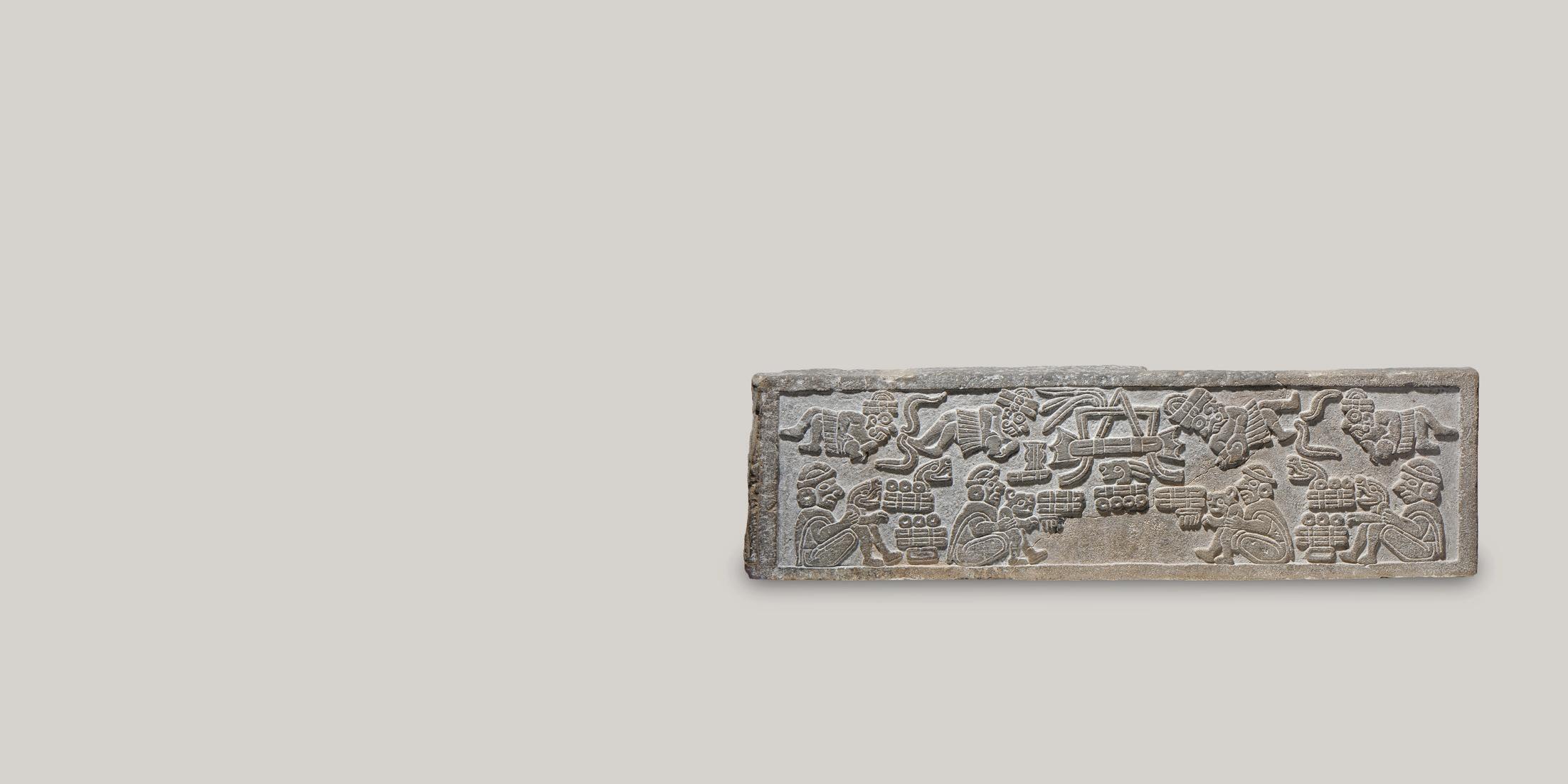
A Tour of Museo Amparo: The Pre-Columbian Collection
Text | Pablo Escalante Gonzalbo
Photography | Juan Carlos Varillas Contreras
Museo Amparo Directory
General Director | Lucia I. Alonso Espinosa
Executive Director | Ramiro Martínez Estrada
Administrator | Martha Laura Espinosa Félix
Collections | Carolina Rojas Bermúdez
Interpretation and Difussion | Silvia Rodríguez Molina
Maintenance | Agustín Reyero Muñoz
Museography | Andrés Reyes González
Guide Credits
Text | Pablo Escalante Gonzalbo
Photography | Juan Carlos Varillas Contreras
Graphic Design | Deborah Guzmán
Mural | Enrique Torralba
Coordination | Silvia Rodríguez Molina
Spanish Copyediting | Claudia Cristell Marín Berttolini and María Elena Téllez Merino
English Translation and Copyediting | Michelle Suderman and Claudia Cristell Marín Berttolini
Printing | Offset Santiago
d.r. © 2019 Fundación Amparo IAP
isbn 978-607-98306-3-2
Second edition 2019
Cover:
Mixtec lintel depicting the rain gods and their possible ritual functionaries
Mixtec
Late Postclassic. 1200-1521 A.D.
Mixtec region
Carved stone
2 Sur 708, Centro Histórico, Puebla, Pue., México 72000 Tel + 52 (222) 229 3850
Open Wednesday to Monday from 10 a.m. to 6 p.m. www.museoamparo.com
museoamparo MuseoAmparo MuseoAmparo.Puebla museoamparo
5 Museo Amparo / The Pre-Columbian Collection 10 25 39 55 75 81 92 106 Gallery 1 / One Space, One time
2 / The Religious World Gallery 3 / Bodies, Faces, People
4 / Society and Customs
5 / Language and Writing
6 / Art, Form, Expression
7 / Death
8 / Cultural changes: the 16th century Contents
Gallery
Gallery
Gallery
Gallery
Gallery
Gallery
A Tour of Museo Amparo: The Pre-Columbian Collection

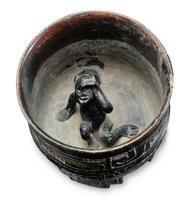
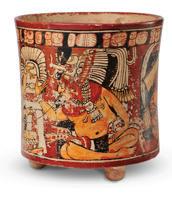

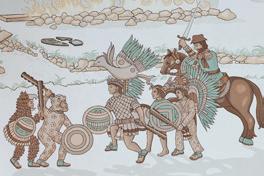
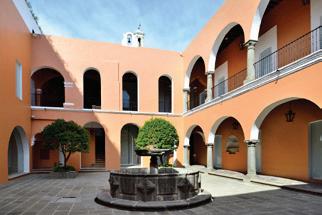
Art, Form, Expression
Society and Customs
Death
Language and Writing



Pre-Columbian Patio
Cultural changes: the 16th century
Timeline
Art
Arch.






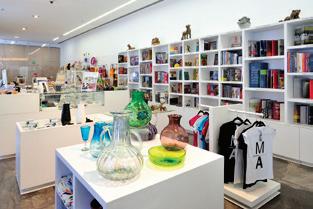

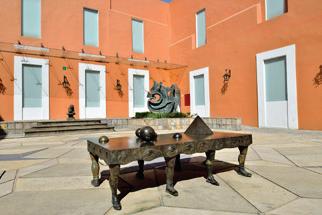



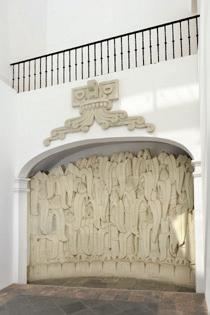 Geometric Patio
Mayan throne backrest
The Religious World
Bodies, Faces, People
Entrance to the Pre-Columbian Collection Lobby
Geometric Patio
Mayan throne backrest
The Religious World
Bodies, Faces, People
Entrance to the Pre-Columbian Collection Lobby
Main Entrance Ticket desk Auditorium
Arch. Pedro Ramírez Vázquez
i
Floor
Gift Shop
Main

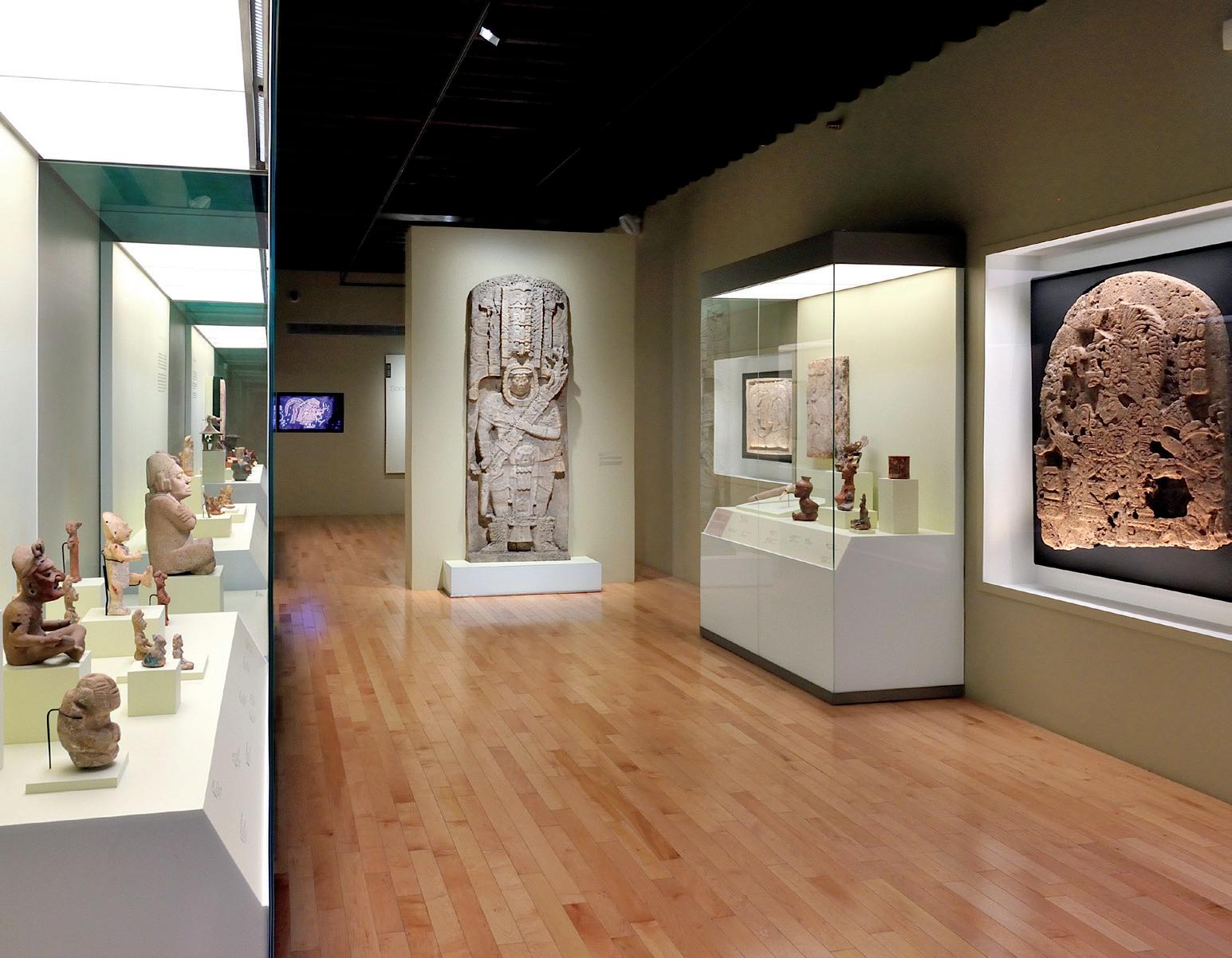
The Pre-Columbian Collection at Museo Amparo
Our ancestors built the cities of Teotihuacán and Monte Albán, wrote the hieroglyphic texts of Palenque and Yaxchilán, and created a community of customs, ideas, institutions, and commerce that linked its various regions. It was an era that produced a vast and varied cultural heritage. People visiting this exhibit will be able to experience a sample of this wealth.
Museo Amparo is home to a large collection of artistic, ceremonial, luxury, and funerary objects, with an emphasis on pieces from Western Mexico, the Balsas River basin, and certain sites in the Valley of Mexico such as Tlatilco, Teotihuacán, Tula, and Tenochtitlan. There are also examples from Central Veracruz, the Usumacinta River basin, Campeche, the Oaxaca Valley, and other areas. This variety allows us to learn about some of the characteristics of Mesoamerican civilization as a whole: its religious thought, economic life, customs, aesthetics, and writing systems.
We would like to invite our visitors to reflect on the themes addressed in the different galleries and showcases, and also to appreciate the intrinsic value of each piece. We hope you will find that Museo Amparo presents an exceptional approach to Pre-Columbian art.
9 Museo Amparo / The Pre-Columbian Collection
One Space, One Time
We often pay a lot of attention to the great achievements of our ancestors: their intellectual or architectural accomplishments, their powerful empires. And indeed, all these are things worth admiring. We also think of the past as the sediment or root from which our present grows. We see the indigenous period as the past tense of our land.
With the mural in this first gallery, we hope to start a reflection on the Pre-Columbian period as a process that began with the domestication of plants and continued through a long cycle that ended with the Spanish Conquest. Each section of the mural depicts some of that era’s main accomplishments and practices.
The map shows only a small selection of the thousands of sites occupied by indigenous cultures, but still gives us an inkling of the vast territory that once made up what we now know as Pre-Columbian Mexico or ancient Mexico.
10
GALLERY 1
1. Throne backrest
This extraordinary sculpture once was the backrest of the throne of a Mayan king. The figure on the right is likely a representation of the king who used this throne around the year 800 a.d. His posture, leaning to one side with his elbow on his knee as he either listened or spoke to an interlocutor, is an exemplary representation of rulers in Mayan art. Another common trait is the frontal portrayal of the ruler, while other court members are shown in profile. The noble person on the left seems to be a woman, and between them, there is a supernatural creature.
This piece is from the Usumacinta River basin, within the Piedras Negras area of influence.
Throne backrest with a sovereign, a courtier (possibly a woman) and a deity in the center Maya. Late Classic. 600-909 A.D. Piedras Negras region, Usumacinta River Limestone sculpted in round bulk
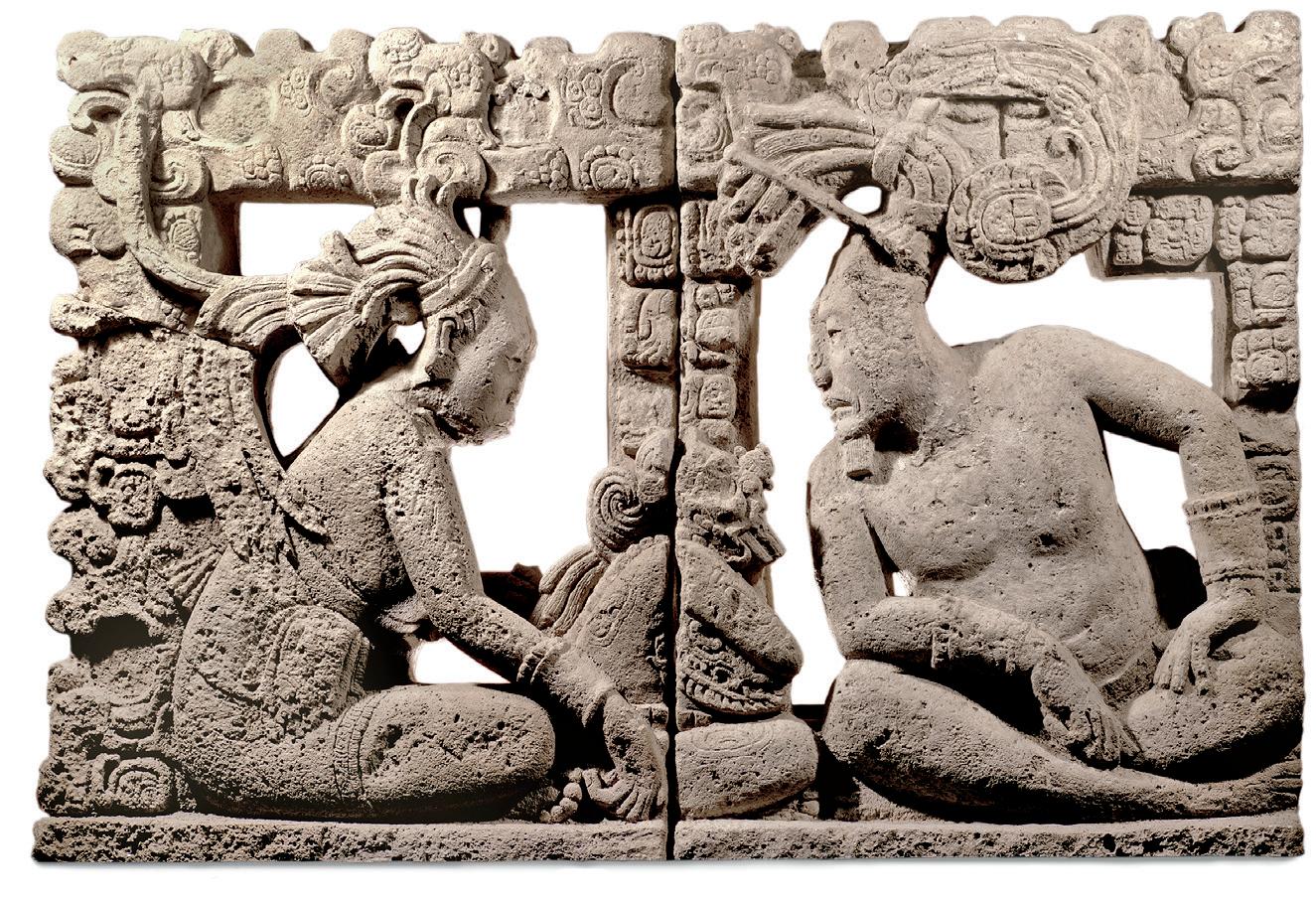
11
Museo Amparo / The Pre-Columbian Collection
MESOAMERICA’S HISTORICAL PROCESS / PANEL 1
Around the year 5000 b.c., groups of hunters and gatherers inhabiting the territory that now makes up Mexico intensified their manipulation of food plants by cultivating and thus initiating the domestication of corn and beans. Other plant species were soon added, including squash, chili, and avocado. Between 5000 and 2000 b.c., these groups grew into agricultural settlements. This marked the beginning of the history of Mesoamerican civilization, which would develop in the regions that enjoyed the most rainfall—in other words, Central, South and Coastal Mexico.
Just as wheat and rice were important in Europe and Asia, corn was the cereal in which the Mesoamerican diet was based.
Mesoamerican agriculture used complex technology that increased the land’s yield through the manipulation of soil and water. On hills, terraces were built to create level fields, control erosion, and to enable the adequate circulation of water. In lake zones such as the Valley of Mexico, artificial islands known as chinampas allowed for high agricultural yields.
In order to build a chinampa, a rectangular fence would be staked to the lake bed, so that it emerged above the water’s surface. The fenced-in area would be filled with mud and aquatic plants, becoming more and more compact under the weight of each new load of soil until it formed a rich, porous bed. In addition, this bed would be anchored by the roots of the trees planted around its edges. People in the Valley of Mexico used chinampas to cultivate the staple crops of Mesoamerica, as well as flowers.
Pottery emerged in Mesoamerica around 2500 b.c.
The vessel shown in the mural is a design typical to the Preclassic period. A similar vessel is on display in the Museum.
12
Gallery 1 / One Space, One Time


The artisan depicted in the mural’s first panel is wearing the typical garment of a Mesoamerican man, a loincloth that the Nahuas called a máxtlatl. This was a band made out of cotton or other fibers that surrounded the waist and draped down in the front and back to cover the buttocks and genitals. The man is shown sitting on his heels, which was the usual resting position for Mesoamerican men.
The beautiful flamingo is just one of the many species of terrestrial animals, fish, and birds that inhabited the lake region of the Valley of Mexico.
MESOAMERICA’S HISTORICAL PROCESS / PANEL 2
Agricultural prosperity, storable surpluses, and social diversification contributed to the urbanization of Mesoamerica over just a few centuries.
Teotihuacán was the largest and most dominant city, and the seat of a great imperial power. It had pavement, drainage, solid dwellings, twenty square kilometers of surface area, and 200,000 inhabitants. People lived in residential complexes with a single entrance from the street and several patios; each was home to as many as twenty people. Rooms were grouped around the different patios, with a family living in each room. The rooms around each patio were likely occupied by brothers along with their wives and children.
One of Mesoamerica’s most important craft activities was textile production, usually carried out by women. Fiber would be spun on a wooden spindle used with a spindle whorl called a malacate; this was a circular clay weight with a perforation in the center.
Weaving was performed on a backstrap loom, which was attached to a house pole and then around the weaver’s waist so she could create tension. Once the warp was taut and ready, the weaver would pass the shuttle back and forth to form the weave.
15 Museo Amparo / The Pre-Columbian Collection
GALLERY 1
Huipiles, skirts, sashes, and loincloths were fabricated on household looms. The weavers would talk amongst themselves as they worked, a practice that was doubtlessly crucial to the preservation of customs and traditions.
MESOAMERICA’S HISTORICAL PROCESS / PANEL 3
Mesoamerican religion developed gradually from the time of the first agricultural settlements. Offerings were a key religious practice, with blood being one of the most common, which usually soaked up dried grasses or papers that were burned afterwards.
The woman in this scene is holding some papers impregnated with blood, ready to be burned as an offering. This design comes from the artwork of Yaxchilán. Smoke rises from a brazier at the top of the temple, which is based on the famed Temple of the Inscriptions in Palenque.
Mesoamerican cultures had different ways of recording their religious beliefs, astronomical and calendrical calculations, and historical events. The most complete record came after the development of writing, especially in the Mayan region. The hieroglyphic inscriptions decorating this panel are also from Yaxchilán.
16
Gallery 1 / One Space, One Time

MESOAMERICA’S HISTORICAL PROCESS / PANEL 4
There is no such thing as civilization without commerce: exchange enriches and completes society, paving the way for urban life and linking different regions. It is one of the fundamental components of civilization.
Mesoamerican merchants traveled in caravans, making long journeys that lasted for many days in order to transport products from one region to another. There were no beasts of burden, so they had to do this on foot. The strongest and youngest merchants would carry bundles weighing up to seventy pounds. This was achieved through the use of the mecapal: a woven fiber band worn across the forehead, with each end attached to a small wooden structure that laid against the bearer’s back, to which the bundle would be tied.
Merchandise from remote districts would be sold in the cities’ public squares. Such markets were called tianquiztli in Nahuatl, the root of the modern Mexican word, tianguis, or temporary market. Many simple items were also sold in the squares, such as basketry chests called petlacalli, and woven fiber mats that served both as beds and as floor coverings in all houses during that period. These were known as pétlatl, the root of the Mexican word petate.
The buildings lining the large urban market squares included warehouses, courts, palaces, and temples.
The quechquémitl was a female garment used both for adornment and for warmth, and was a complement of the huipil. It was rhomboidal in shape, with one point hanging over the chest in the front, and the other hanging down the back.
18
Gallery 1 / One Space, One Time

MESOAMERICA’S HISTORICAL PROCESS / PANEL 5
Seated on their thrones made of reeds and basketwork, called icpalli in Nahuatl (the root of the Mexican word equipal), governors held absolute power, attenuated only by the council of elders, noblemen, and warriors. Palaces were usually crowned with battlements, and had spacious patios and long colonnades.
In the final phase of Mesoamerican history, military activity was one of the government’s primary responsibilities, and the sovereign presented himself as the army’s supreme commander. Round shields or bucklers known as chimalli in Nahuatl were present at every ceremony as symbols of power, but they were also effective defensive weapons for deflecting enemy arrows.
The ichcahuipilli was another element of indigenous weaponry: this was a vest stuffed with cotton that impeded the penetration of arrowheads and protected against the obsidian blades inserted into wooden swords, known as macuáhuitl. The Spaniards also adopted this lightweight and sturdy indigenous defensive garment.
The war that Hernán Cortés’s army waged against the Mexica Empire allowed the Spanish Crown to assimilate many ancient lordships. Technical advantages such as the use of horses and cannons were decisive factors, but there were also many indigenous groups, enemies of the Mexicas, who decided to ally with the Spaniards.
20
Gallery 1 / One Space, One Time





































Southeast Yucatán Quintana Roo Campeche Tabasco Chiapas Oaxaca Guerrero West Sinaloa Nayarit Jalisco Colima Guanajuato Michoacán Center State of Mexico Mexico City (CDMX) Tlaxcala Puebla Morelos Hidalgo Gulf Coast Tamaulipas San Luis Potosí Veracruz North Querétaro Baja California Sur Baja California Sonora Chihuahua Coahuila Nuevo León Durango Zacatecas Aguascalientes Zacapu Teuchitlán Tuxcacuesco Amapa Los Ortices Capacha Culiacán Ixtlán del Río Michoacán Colima Jalisco Nayarit Sinaloa La Quemada Monte de Huma Altavista La Ferrería (Schroeder) Loma San Gabriel Cueva de Cueva del Cañón Zacatecas Durango Baja California Baja California Sur Sonora Chihuahua Coahuila Aguascalientes El Vallecito Cueva de la Pintada Boca San Julio Caborca Paquimé Cuarenta casas Cueva de la Olla
Gulf of Mexico



































































































Mesoamerica Arid America Oasisamerica Quintana Roo Yucatán Chichen Itzá Dzibilchaltún Mayapán Uxmal Sayil Labná Cobá Tulum Dzibanché Xpuhil Edzná Calakmul Palenque Comalcalco Toniná Mirador Yaxchilán Bonampak Chiapas Tabasco Campeche La Venta Coixtlahuaca Mitla Dainzú Huijazoo Yagul San José Mogote Lambityeco Monte Albán Oaxaca Soledad de Maciel Xochipala Teopantecuanitlán Juxtlahuaca Oxtotitlán Guerrero Tzintzuntzan Pátzcuaro Chupícuaro Guanajuato
San Lorenzo Yohualichan Tajín Cempoala La Mojarra Tres Zapotes Castillo de Teayo Las Flores Tamuín Tamtoc Veracruz Cantona Cacaxtla Cholula Cuauhtinchan Valle de Tehuacán Cuauhnáhuac Chalcatzingo Xochicalco Malinalco Teotenango Teotihuacán Tula Cuicuilco Tlatelolco Tlatilco Tenochtitlan Calixtlahuaca Tlaxcala Puebla Morelos Hidalgo State of Mexico CDMX Río Verde Villa de Reyes San Antonio Nogalar Balcón de Moctezuma Boca de Potrerillos Ranas Toluquilla Huma la Candelaria Cañón Angosto Querétaro San Luis Potosí Tamaulipas Zacatecas Coahuila Nuevo León Aguascalientes
ANCIENT MEXICO, MESOAMERICA
Ancient Mexico was home to a huge variety of cultures. The greatest difference is found between the hunters and gatherers of the North, and the cultivators of the South. The present-day states of Baja California, Baja California Sur, Coahuila, and Nuevo León were largely populated by gatherers, as were Sonora and Chihuahua, and parts of Tamaulipas, Zacatecas, and San Luis Potosí. Some call this vast region “Arid America.”
Mesoamerica is the name given to the central and southern regions of what is now known today as Mexico, where the Mesoamerican civilization developed. From Central America to the Sinaloan coast in the West, and Tamaulipas in the East, there was intensive agriculture that created enough surplus to sustain an urban population. The different regions of Mesoamerica maintained constant connections throughout history by means of commerce, migration, marriages among the nobility, and even war. Such relationships allowed different ethnic groups to consolidate a common culture, religious thought, mythology, and other cultural traits such as the ballgame, human sacrifice, the use of codices, and the combined 260-day and 365-day calendars.
One strip of Northern Mesoamerica was characterized by its instability: there were urban settlements in Querétaro linked to Teotihuacán which were later deserted, as well as several settlements in the mountainous regions of Zacatecas and Durango that were abandoned centuries before the Conquest. This northern zone is sometimes called Marginal Mesoamerica. Finally, the term Oasisamerica refers to several agricultural settlements with a distinct culture from that of Mesoamerica, situated along small rivers and ravines surrounded by arid zones; some were in Chihuahua, while others occupied areas of what is now the United States, such as Arizona and Colorado.
24
Gallery 1 / One Space, One Time
The Religious World
In contrast to our present time, most everyday life experiences had some religious meaning for the cultures of ancient Mexico. Many moments of the day called for an offering to be made, or for some other kind of ritual to be performed. In the vast geographical area of Mesoamerican civilization, there was not a unifying religious text like the Bible or the Koran, nor was there a prophet accepted by all, although Quetzalcóatl was a figure of great renown in every region. The Mesoamerican religious unity, which is undoubtable, was based on oral tradition and practices passed on from generation to generation, and from one region to another.
Certain components of the Mesoamerican religious thought—such as the idea of the sacred mountain that provided humanity with water and riches—can be documented in images dating as far back as 1000 b.c. Mesoamerican religious life also included ancient and important rites such as burnt offerings of copal resin, blood, and human sacrifice.
25 Museo Amparo / The Pre-Columbian Collection
GALLERY 2
MANKIND FACING THE FORCES OF THE WORLD
The natural world, the movement of celestial bodies, the power of floods or whirlwinds were all seen as expressions of the forces animating the world. And on occasion, such forces could be terrible: for example, when manifested in the form of the roar of a wild animal. Many tales and fragments from the oral tradition recorded during the Colonial era reflect a certain fear towards the natural world, especially those areas far away from towns or villages, such as forests and ravines.
1. Woman carrying a vessel using a head strap and a weasel

It was common practice to leave the village in search of water or firewood. Far from home, wayfarers were exposed to the uncertainties brought on by the transit of sacred forces. For example, it was considered bad luck if a weasel crossed one’s path.
Shaft tomb tradition.
Elephantine style
Late Preclassic-Early Classic.
300 B.C.-600 A.D.
Jalisco
Modeled clay with pastillage
26
Woman carrying a vessel using a head strap
Gallery 2 / The Religious World
Weasel Veracruz
Late Classic. 600-900 A.D. Southern Veracruz
Modeled clay with incised decoration
Snake Mezcala tradition
Late Preclassic-Late Classic. 500 B.C.-900 A.D. Middle Balsas River basin
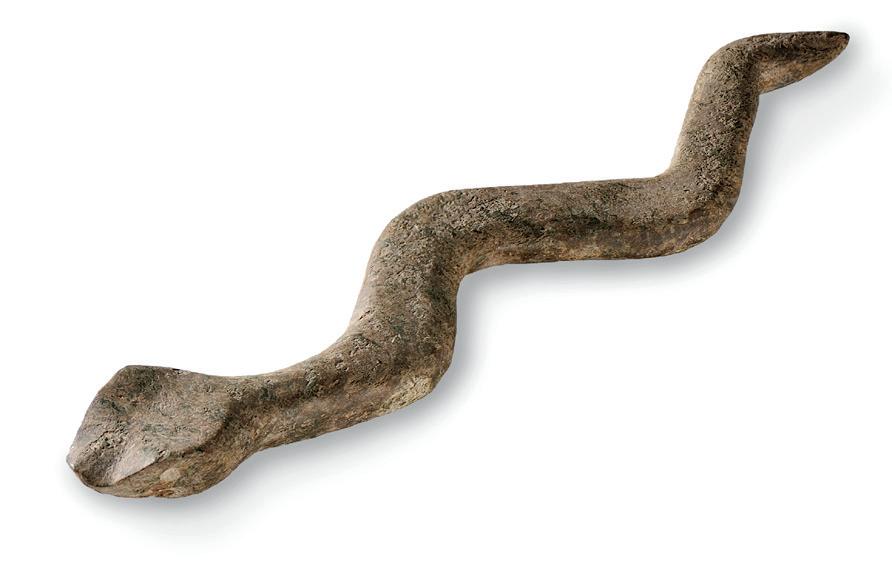
Carved and polished stone
Peccary shaped vessel Tlatilco


Middle Preclassic, Manantial phase. 1000-800 B.C. Valley of Mexico
Modeled and polished clay
27
Museo Amparo / The Pre-Columbian Collection
2
GALLERY
MYTHS AND THE FOUNDATIONS OF ORDER
Myths may seem like fantastic and even outlandish tales to our ears, but they were an essential tool for explaining and describing the order of the world. Since remote times, the cultures of Mesoamerica explained every geographical, biological, and even psychological or moral event through stories in which sacred forces had names and responsibilities of their own.
2. Votive axe sculpture of a plump-cheeked old man
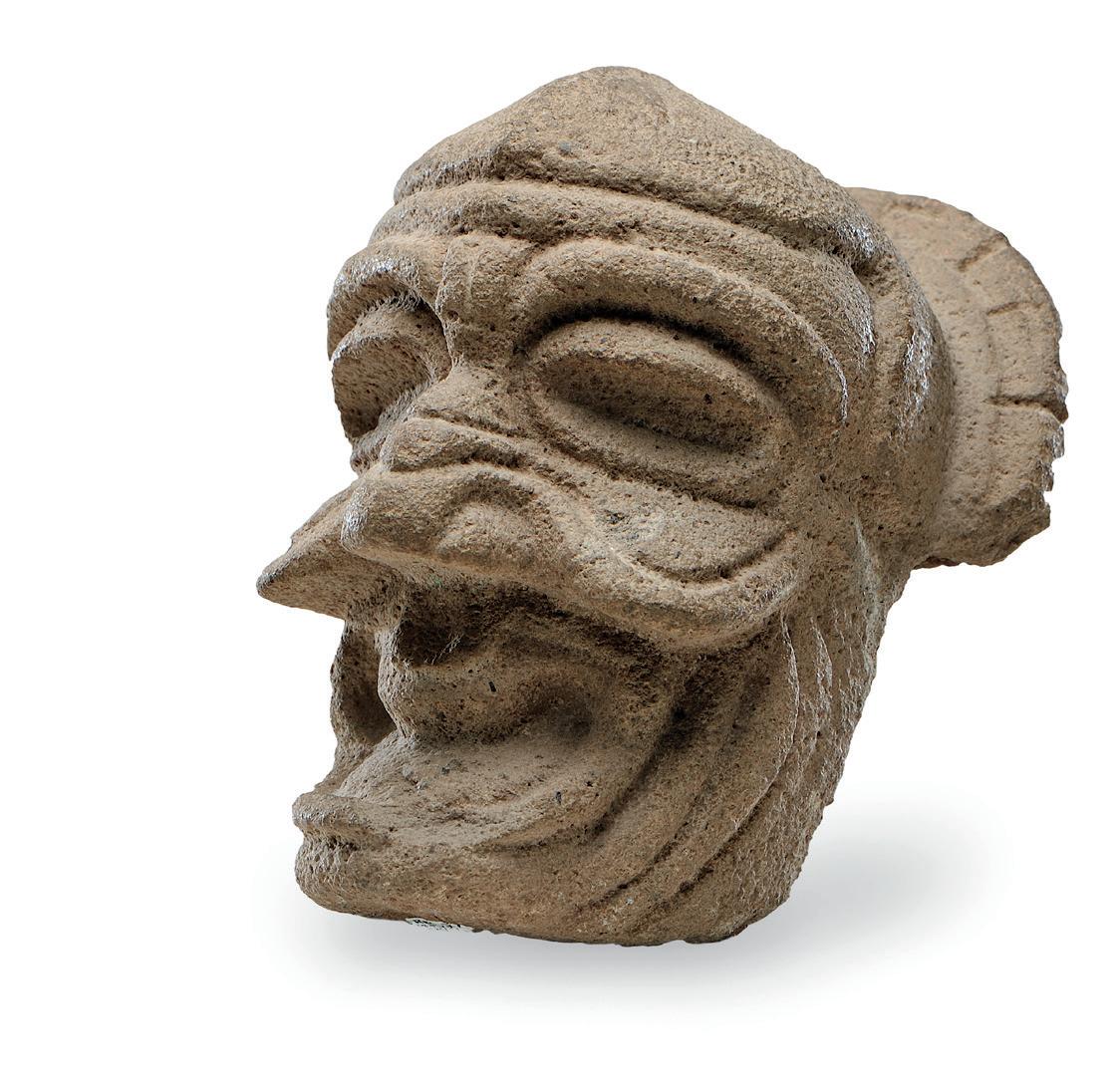
Mexico’s ancient cultures considered old age as a strength, as many rural communities still do. Elders were seen as strong, wise, and full of the sacred warmth that accumulates in the soul. Among their many responsibilities and privileges, it was their job to remember and retell the myths that constituted a given community’s religious thought.
“Hacha”. Votive axe
sculpture of a plumpcheeked old man
El Tajín culture
Epiclassic. 850-1000 A.D.
Papaloapan River basin, Veracruz
Carved volcanic stone
28
Gallery 2 / The Religious World
Squatting hunchback
Shaft tomb tradition
Ameca-Etzatlán style
Late Preclassic-Early Classic.
300 B.C.-600 A.D.
Jalisco
Modeled clay with pastillage, engobes and burnishing
Seated man

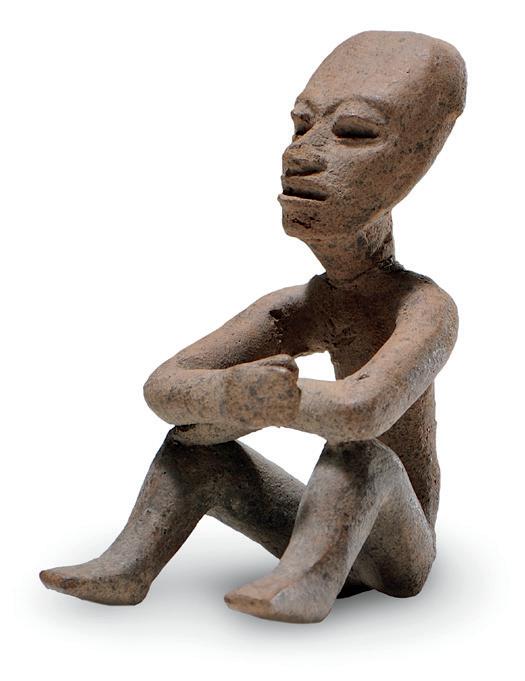
Teotihuacan
Early Classic. 200-600 A.D.
City of Teotihuacán
Modeled clay; molded face
THE STRUCTURE OF THE COSMOS
Plants and animals, mankind and its crops and villages, all these things existed on the earthly plane, at the center of a system of layers or levels. The upper levels were identified with masculine, solar and dry forces, while the levels of the underworld were related to feminine, lunar and humid forces.
Communication among these worlds occurred by means of the vertical supports joining them, allowing sacred forces to act and interact on the terrestrial level. Some representations included five supports: one at the center and one at each corner of an imaginary square. In reality, all trees, mountains and ravines were considered to be channels or structures for communication among sacred forces.
29 Museo Amparo / The Pre-Columbian Collection
GALLERY 2
3. Architectural decoration with four-petaled flower and Napatecuhtli
A circular stone with a hole in the center was a symbol of the place occupied by human beings in the center of the world. The main communicating supports, situated at the four corners of the earthly plane, could be represented as trees, as reptiles standing upright, or as images of anthropomorphic gods. We present here one of the napatetecuhtin, the lords of the four directions.
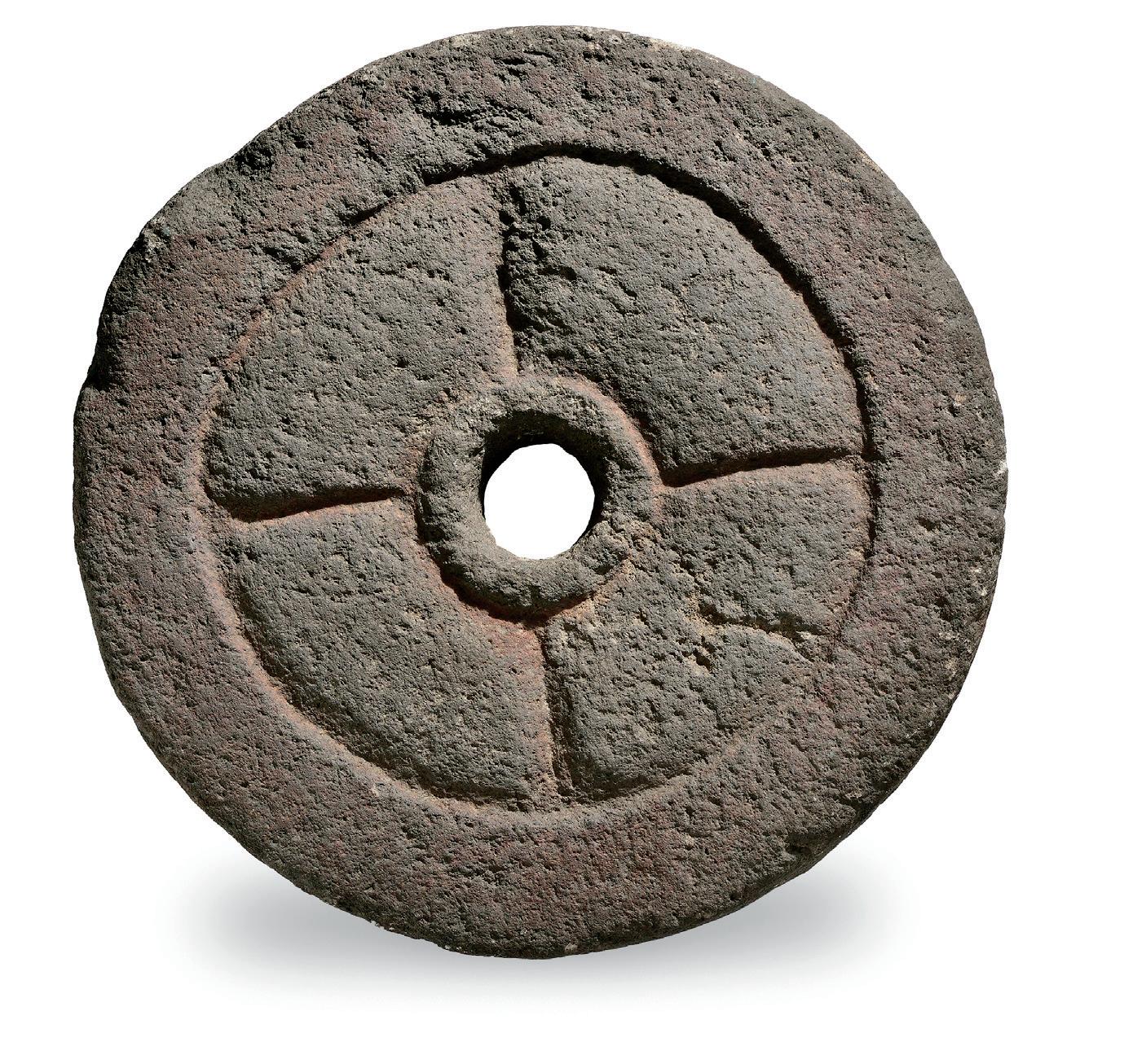
Architectural decoration with four-petaled flower
Teotihuacan
Early Classic. 200-600 A.D. Valley of Mexico, probably Carved stone
30
Gallery 2 / The Religious World
Napatecuhtli Nahua. Mexica style Late Postclassic. 1350-1521 A.D. Central Mexico Plateau Stone sculpted in round bulk with relief

31
Museo Amparo / The Pre-Columbian Collection
GALLERY 2
Felines symbolized the nocturnal underworld in the same way that eagles and birds represented the celestial world. Snakes also emerged from the underworld, and when they stood upright and were covered with feathers or fur, they represented the communicating supports.
Feline
Shaft tomb tradition.
Comala style
Late Preclassic-Early Classic.
300 B.C.-600 A.D. Colima


Modeled clay with engobe and burnishing
Shaft tomb tradition. Comala style
Late Preclassic-Early Classic.
300 B.C.-600 A.D.
Colima
Modeled and incised clay
32
4. Feline
in a resting attitude
Coiled water snake
Gallery 2 / The Religious World
FEMALE, FERTILIZATION, WEAVING
In ancient Mexico, deities were believed to have created the earth from a gigantic female reptile, thus linking the underworld to the feminine principle: agricultural land, fertile soil, wet subsoil. Beneath the surface laid the feminine principle with great potential for reproduction. It only required downward perforation and fertilization with the warm, solar seed.
5. Group of spindle whorls
In addition to their technical function, each spindle whorl resembles a tiny cosmogram. A shaft traverses the center, and the spinning element forms the yarn, just as the forces that created the world trace circles around the world’s supports.

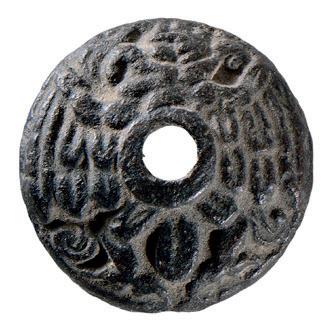
Malacates (spindle whorls) with different designs
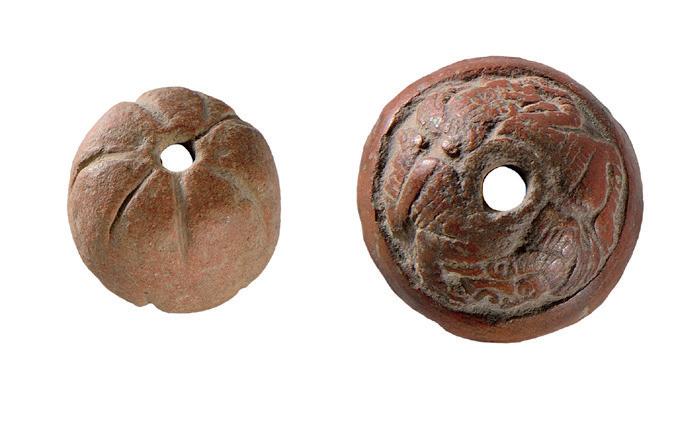
Modeled and incised clay

33
/
Museo Amparo
The Pre-Columbian Collection
GALLERY 2
HUMAN CELEBRATIONS
Rituals and ceremonies held in front of temples may be viewed as the triumph of religious rationality over the natural world. By understanding the character and function of sacred forces, given that their effects were described in religious calendars, human beings carried out rituals that allowed them to contribute to that sacred order.
6. Drinking man
Banquets were an important part of traditional indigenous celebrations. Long nocturnal feasts would be held after certain political rites, family ceremonies or calendrical rituals as a pleasurable reward that brought the ritual itself to an end. The conventional representation of someone drinking pulque is a figure raising a bowl to the mouth.
Drinking man
Shaft tomb tradition. Comala style
Late Preclassic-Early Classic.
300 B.C.-600 A.D.
Colima
Modeled and burnished clay
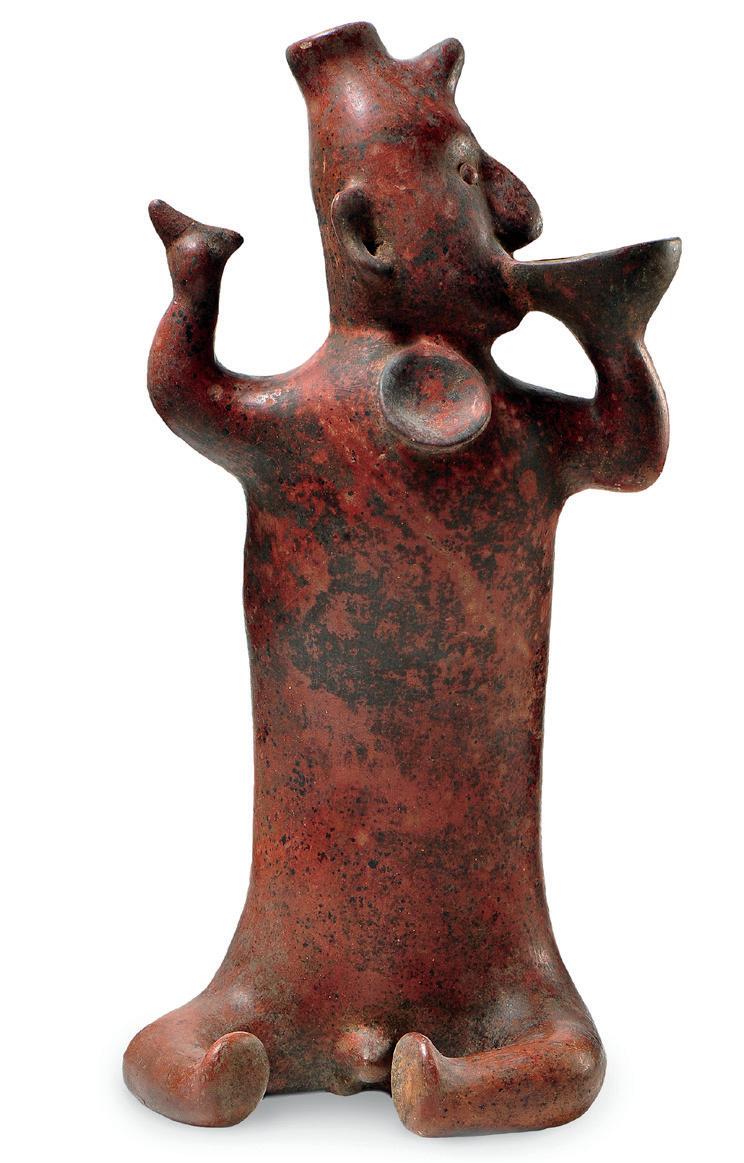
34
Gallery 2 / The Religious World
Dignitary with a headdress of conical shapes and a necklace of shells or pods Shaft tomb tradition.
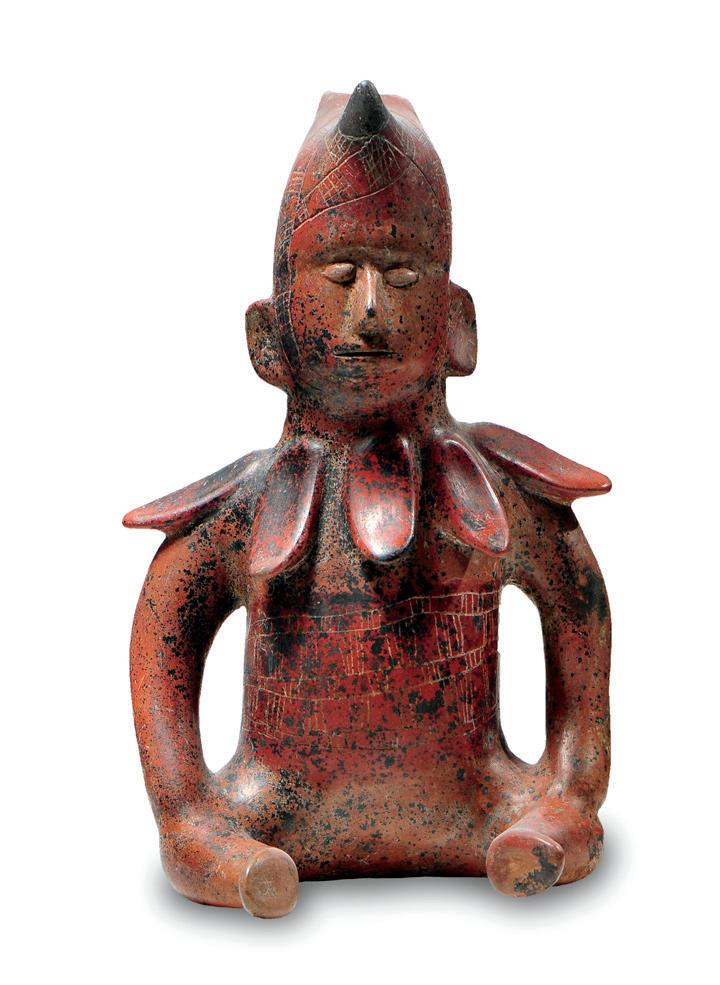
Comala style
Late Preclassic-Early Classic. 300 B.C.-600 A.D.
Colima
Modeled and burnished clay with sgraffito
OFFERINGS TO THE GODS
The most important religious act was the presentation of offerings to the gods; such gifts were their nourishment. Offerings were presented on plates and in cups, on braziers, at the base of religious platforms, in temples and upon altars.
The most common offerings were copal, flowers, and human or animal blood.
ESSENCES, AROMAS, FIRE
The gods are invisible, light and volatile. They inhabit things for a time, then leave them and continue on their way, moving up and down through the world’s strata. In order to nourish them, they must be presented with an offering linked to their nature, something they can absorb and appropriate. This is why Mesoamerican offerings were always made through combustion or gasification. Deities were only able to absorb the essences of things: the fragrance of flowers, or the smoke or smells of other offerings.
35 Museo Amparo / The Pre-Columbian Collection
GALLERY 2
7. Incense burner
Every morning at dawn, embers would be stirred into flames in household and temple braziers, then finely powdered copal resin crystals would be sprinkled over them. A crackling sound would be heard, then fragrant white copal smoke would rise in dense clouds from the coals. In a sense, this was a succulent breakfast for the gods.
The copal offering would be repeated at different times throughout the day and during specific ceremonies. Using incense burners, the aromatic smoke could be directed at a specific individual or image.
Incense burner with handle and tray

Classic. 200-900 A.D.
Modeled clay with matte engobe
God of Fire
Teotihuacan
Early Classic. 200-600 A.D. City of Teotihuacán
Sculpted stone
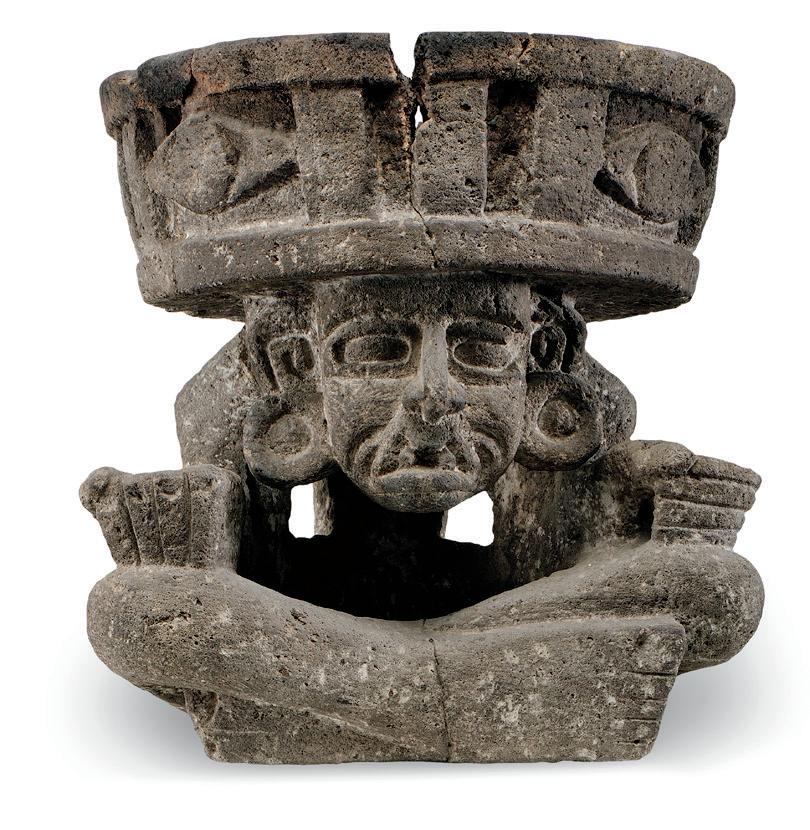
36
Gallery 2 / The Religious World
BLOOD OFFERING
Blood offerings were seen as particularly valuable, because what was presented to the gods was the same substance that nourished and gave life to animals and humans. This offering was practiced not by the entire population, but rather by priests and on occasion by a noble or warrior.
After being sacrificed, the blood of quails or other birds would be gathered using balls of straw or grass. The most valuable blood for offerings was human blood. After being spilled, all the blood would have to be burnt or scorched, because by being transformed into smoke, it became nourishment for the gods.
Human sacrifice produced the most valuable offering of all: the victim’s still-beating heart, and sometimes other organs, would be extracted from the body, and the resulting blood would be smeared over temple altars and walls so that its odor might be absorbed by the gods. In the end, the heart would be incinerated.
Xochipala tradition
Early Preclassic-Middle Preclassic. 1200-900 B.C.
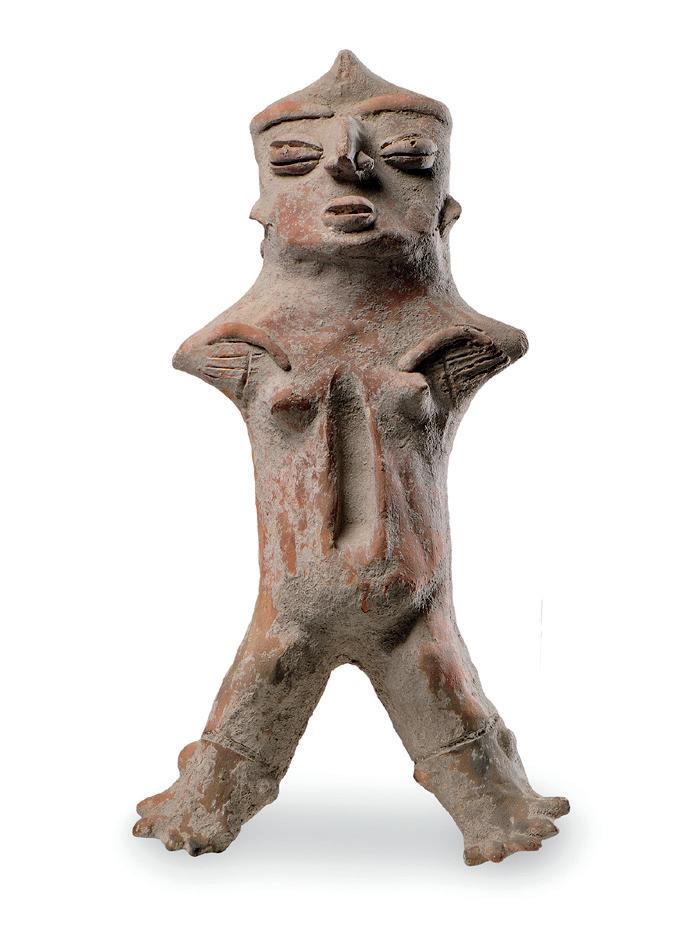
Middle Balsas River basin
Modeled and incised clay with pastillage
37 Museo Amparo / The Pre-Columbian Collection
8. Anthropomorphic figure with incision in thorax and abdomen
Anthropomorphic figure with incision in thorax and abdomen
GALLERY 2
THE BALLGAME
One of the ceremonies that could precede a human sacrifice was the ballgame, juego de pelota in Spanish. This game was in fact a complex ritual that involved much more than human sacrifice. It has been suggested that the rubber ball’s movement through the air as it traversed the court both symbolized and magically stimulated the sun’s apparent movement over the earth.
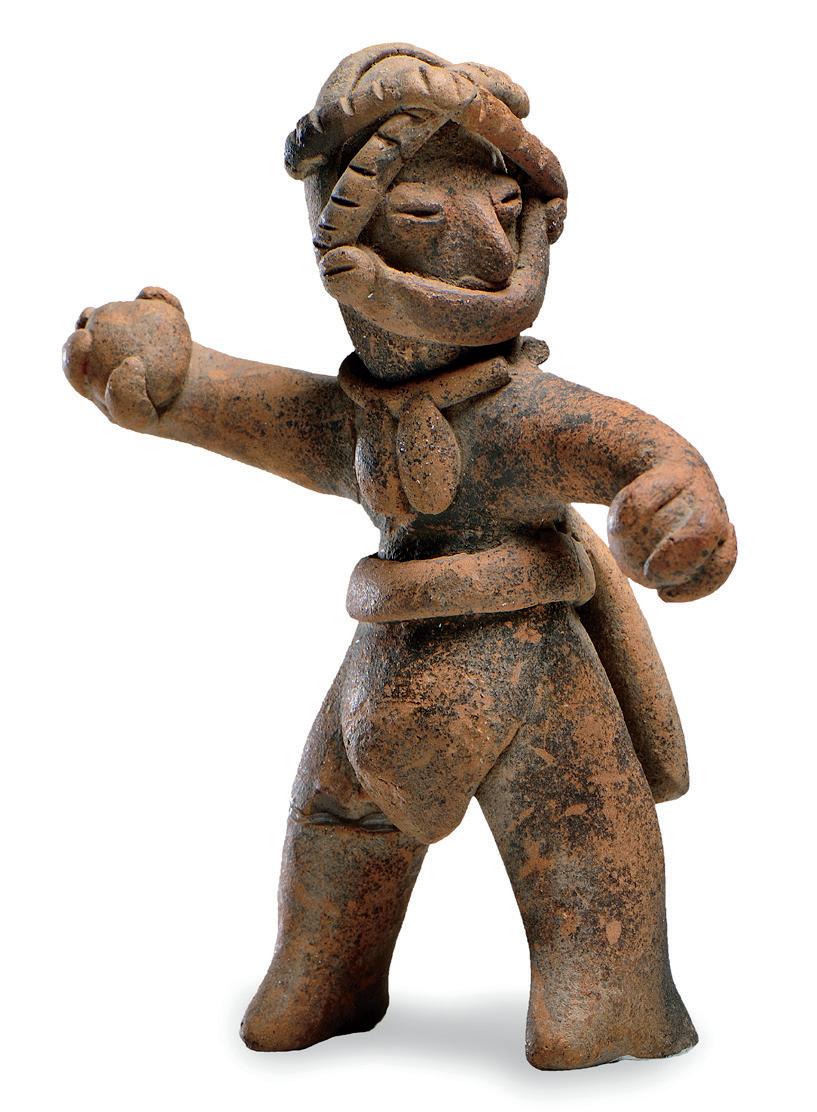
The ritual ballgame was played on special courts, and the players were usually warriors. The notion that winning or losing the game determined who would be sacrificed seems to have no foundation in reality. Nevertheless, it is true that some prisoners would be ceremonially sacrificed through decapitation after a game.
Players would wear leather pads to avoid injury by the heavy rubber ball. One of such protectors was a thick belt.
It is also true that, in addition to the ritual and official game, it would also be played as a sport in city streets and squares.
Shaft tomb tradition.
Tuxcacuesco-Ortices style
Late Preclassic-Early Classic.
300 B.C.-600 A.D.
Southern Jalisco and Colima
Modeled clay with pastillage
38
Ball player with mask
Gallery 2 / The Religious World
Bodies, Faces, People
Mesoamerican artists left behind extraordinary examples of their skilled representation of the human body. Throughout Mesoamerica, from the Olmec period to the time of the Mexica, they were incessant producers of images of human beings and their expressions. Stone sculptures, clay figures and mural paintings were the three most common media for anthropomorphic representations. Most human figures were representations of the dead, of governors, priests or gods, and by and large, had some religious significance. However, the Mesoamerican repertoire was not entirely dominated by ceremony or solemnity; on the contrary, there were depictions of movement, work, pain, conversation, as well as old age, obesity, disease and joy.
Some of the pieces we know display a clearly naturalistic intent, resulting in the representation of realistic anatomical proportions and individualized physiognomies and facial expressions. But there are also many schematic and highly abstract images. There was not a unified system of representation in Mesoamerica, nor was there a linear progression from naturalism to abstraction or vice versa. Both possibilities were latent in Mesoamerican art from all eras and regions.
39 Museo Amparo / The Pre-Columbian Collection
GALLERY 3
BODIES AND GESTURES
We should not expect Mesoamerican art to behave in the same way as modern Western art. Costumbrismo is not found in Mesoamerican art, nor is portraiture per se, nor is the representation of moods and feelings, even though some indigenous creations demonstrate that potential. Any predominantly religious, ceremonial or courtly art will have its peculiarities and limitations. But a cursory examination of a few examples of Mesoamerican anthropomorphic images is enough to confirm that the characterization of the human body and its expressions was always central to the artists’ interests.
MAN, WOMAN, NUDITY
For a civilization that left little evidence of a generalized practice of eroticism, Mesoamerica produced some eloquent human nudes. The oldest artistic expressions in Mesoamerica were female nude figurines, linked to an ancient Earth cult. Then came funerary images: representations of the deceased and members of his family for placement alongside burials.
It is also possible that some of the nude figures that have survived to this day were in fact representations of gods, either to exalt some aspect of the god’s sexual nature or because the images were meant to be dressed in textiles that have since disappeared.
1. Female figure
Certain stone carvings from the Mezcala tradition attain a delicate and striking naturalism without abandoning the schematic language and symmetry characteristic of this sculptural style: for example, this mature woman with an exposed vulva and sagging breasts and belly, that speak of repeated pregnancies.
40
Gallery 3 / Bodies, Faces, People
There is no sheer explanation for the gash across the woman’s abdomen: an allusion to sacrifice or perhaps to a primitive cesarean section? The truth is that her closed eyelids indicate that the carving represented a dead woman.
Female figure with arms over the abdomen

Mezcala tradition
Late Preclassic-Late Classic. 500 B.C.-900 A.D.
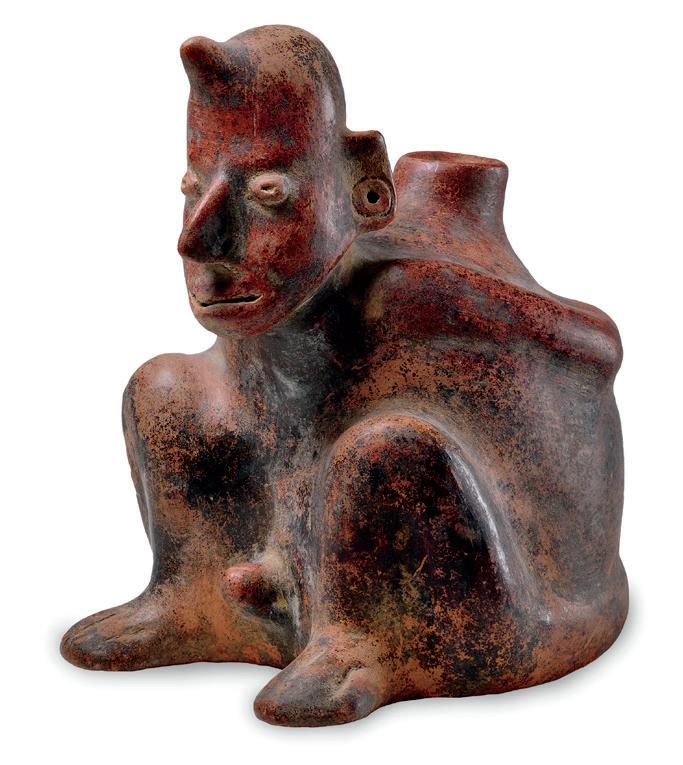
Middle Balsas River basin Carved stone
Captive with erect penis
Shaft tomb tradition. Comala style
Late Preclassic-Early Classic. 300 B.C.-600 A.D.
Colima
Modeled and burnished clay
41
Museo Amparo / The Pre-Columbian Collection
GALLERY 3
Certain cultural traditions are characterized by their quest for naturalism. For example, imitation of nature appears to have guided Greek art from the Cycladic period to the Classical era. Other traditions prefer more abstract expressions. In the case of Mesoamerica, we find variations from one region and era to another, and even among individual artisans working in the same style. The Mezcala tradition is probably one of the more abstract of them. Its stone carvings were achieved primarily using the abrading technique, repeatedly sliding a bow with a tense cord over the stone as if it were a hacksaw. This technique resulted in bilateral symmetry and a degree of schematicism, reducing the body to a few basic lines.
2. Standing man
This piece is an excellent example of the merits and limitations of using the abrading technique when carving stone. The gap between the legs, which appear slightly bowed, may be the best indication of the cord’s progress. The arms are indicated with straight lines, as are the eyes. However, the curvature of the neck and the light lines of expression on the brow lend the figure some expressiveness. This is particularly noteworthy given the piece’s overall economy of lines.
42
ABSTRACTION
Gallery 3 / Bodies, Faces, People
Standing man with arms over the abdomen
Mezcala tradition
Late Preclassic-Late Classic. 500 B.C.-900 A.D.
Middle Balsas River basin
Carved stone
3. Anthropomorphic figure
Certain figures from the Mezcala tradition feature faces whose naturalism comes from complementary carving techniques such as perforation and incision, and a polished finish that produces surfaces of variable curvature. The faces of these pieces recall certain sculptures from the Olmec period. This carving method may also be found on masks and some Classic-period figurines from Oaxaca and the Valley of Mexico.

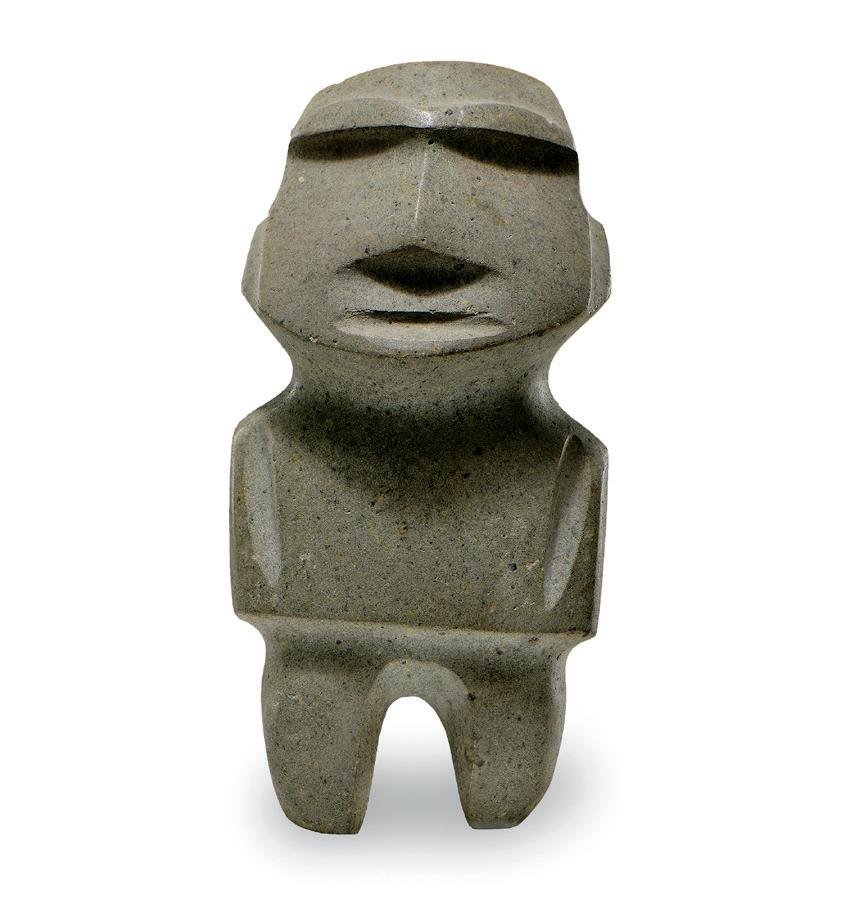
Broken anthropomorphic figure
Mezcala tradition
Late Preclassic-Late Classic. 500 B.C.-900 A.D.
Middle Balsas River basin
Carved, incised and polished stone
43
/
Museo Amparo
The Pre-Columbian Collection
GALLERY 3
IDENTITY AND POSTURE
Mesoamerican anthropomorphic representations have a limited repertoire of postures and gestures corresponding to certain social conventions. Warriors typically stand erect and display a degree of solemnity. Women are often shown seated with folded legs: a posture which was frowned upon for men, at least during the Postclassic period. Among many different arm positions, there is one that seems to be associated with grieving: vertical upper arms, with forearms bent at a ninety-degree angle and hands touching at the level of the abdomen.
4. Woman
This sculpture clearly belongs to the Nahua repertoire from the Valley of Mexico around the time of the Spanish Conquest. It probably represents one of the goddesses linked to sexual pleasure. Despite the carving’s crudeness, her coiffure and youthful appearance indicate that it is Xochiquetzal, which would explain her apparently erotic gesture of holding her breasts.

Woman holding her breasts
Nahua. Mexica style
Late Postclassic. 1350-1521
A.D.
Central Mexico Plateau
Sculpted and polished stone
44
Gallery 3 / Bodies, Faces, People
5. Maize goddess
This figure’s formality and simplicity reflect the ideal image of a Nahua woman, most likely a noblewoman: serene and seated with folded legs, modestly covered with a quechquémitl, and with carefully coiffed hair. However, this is not a depiction of a real woman but rather of a goddess, probably Xilonen, protector of cornfields bearing young cobs.
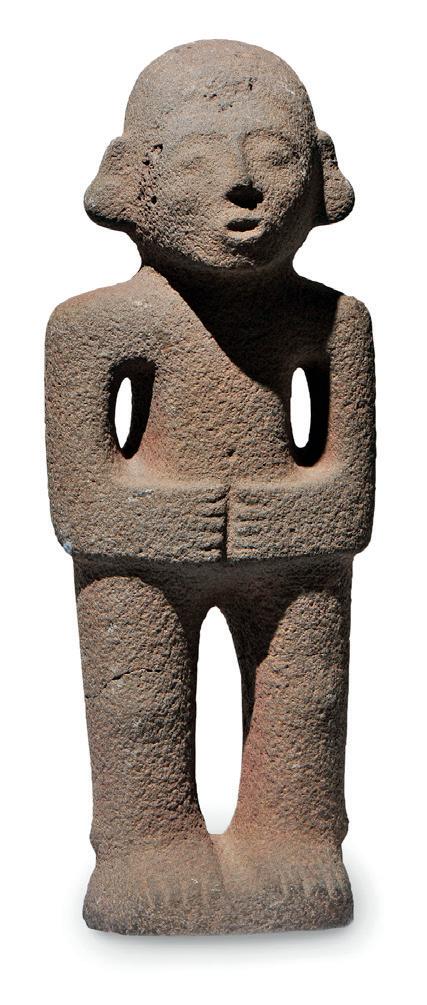

Maize goddess
Nahua. Mexica style
Late Postclassic. 1350-1521 A.D.
Valley of Mexico, probably Tenochtitlan
Carved and polished stone, with paint
Man with hands over the abdomen
Huasteca
Postclassic. 900-1521 A.D.
Huasteca, Northern Veracruz
Carved and polished stone
45 Museo
/
Amparo
The Pre-Columbian Collection
GALLERY 3
GESTURE AND EXPRESSION
Early artistic expressions from the Middle Preclassic and figurines from Western Mexico display the greatest variety of gestures and expressions. Representations from later periods become more stereotyped, and their gestures more reiterative.
Common male postures include crouching and sitting cross-legged, with arms resting on the knees. In ceremonial contexts, male figures are also seen kneeling on one knee in a position similar to genuflection. Forearms may be placed over the chest, either crossed or on the diagonal, in a position related to religious veneration.
6. Man in reflective posture
The style and iconography from the Olmec tradition expanded through many regions of Mesoamerica, as seen in this figure from the Balsas River basin. From its highest point, where the Balsas River joins the Atoyac, to its midpoint, near the Mezcala River, this region had one of the highest concentrations of pieces with Olmec characteristics. This figure pertains to a sub-style known as Las Bocas, mainly found near Izúcar de Matamoros.
Many Museum visitors, as well as art scholars and critics, consider it to be a masterwork because of its striking expression: a mature man, sitting serenely, in reflection. His arms lean on crossed legs, and he rests his chin on his left hand, resulting in a gesture that is often associated with rational meditation.
This is likely the image of the chief or cacique of an important village, and would have been buried along with his remains.
46
Gallery 3 / Bodies, Faces, People
Man in reflective attitude
Olmec

Middle Preclassic. 1200-500 B.C.
Las Bocas (Caballo Pintado), Puebla
Modeled clay, with several engobes and delicate incisions
47
Museo Amparo / The Pre-Columbian Collection
GALLERY 3
Man holding his hand to the mouth
Olmec
Middle Preclassic.
1200-500 B.C.
Las Bocas (Caballo Pintado), Puebla
Modeled clay with incisions and engobe
7. Seated woman
This piece belongs to the style known as Xochipala, from the middle of the Balsas River basin. This style was developed in a small area, and is contemporary to the early phase of Olmec ceramic sculptures. It appears to be a local expression with a similarly naturalistic intent. Xochipala figures were painted with a kind of slip called engobe prior to cooking, thus lending the ceramic body a more dynamic presence.
The seated woman seems to be leaning on one hand, suggesting repose or relaxation. Her face is raised as if in contemplation. Her expressive features were attained through the application of tiny strips of clay, in a technique known as pastillage.
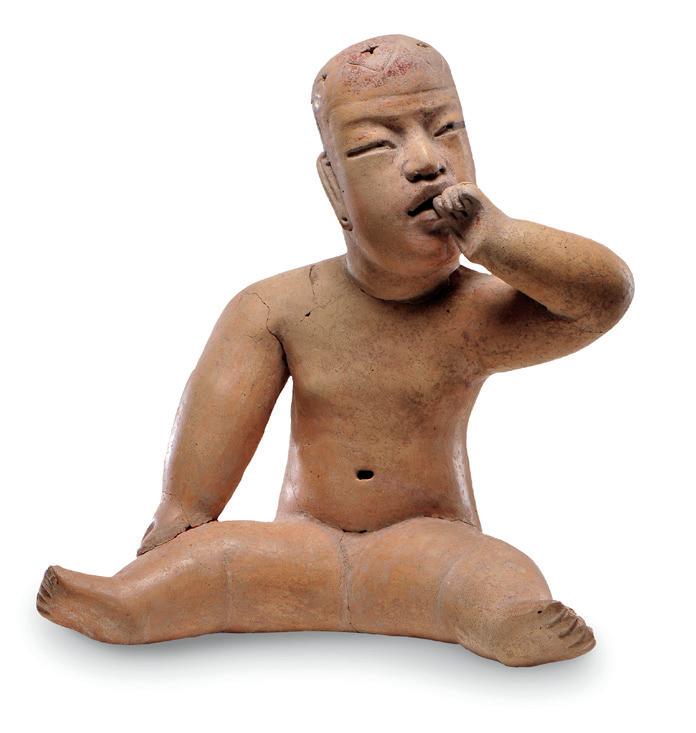
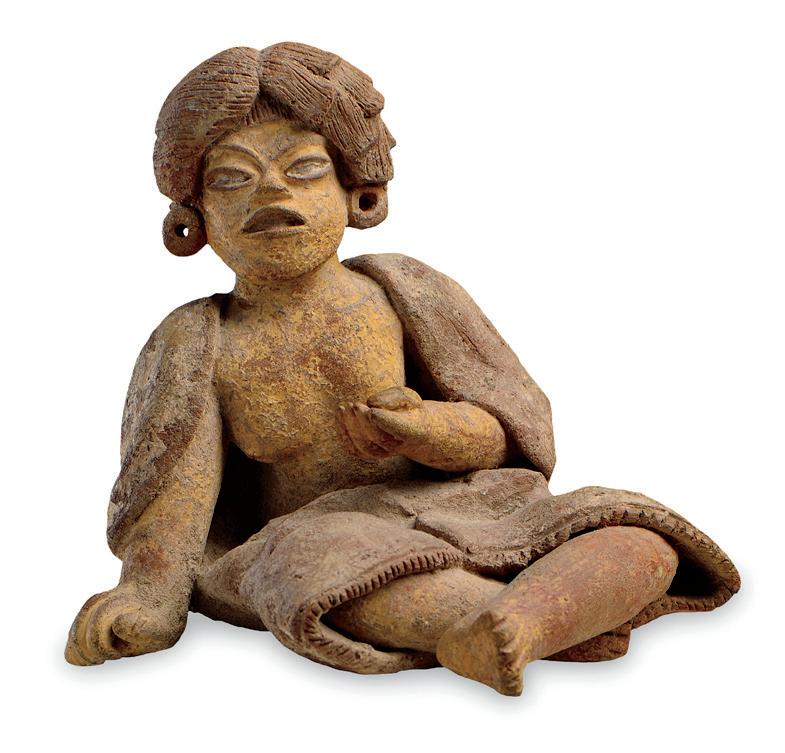
Seated woman
Xochipala tradition
Middle Preclassic.
1200-500 B.C.
Middle Balsas River basin
Modeled clay with pastillage and several engobes
48
Gallery 3 / Bodies, Faces, People
Colonial codices provide evidence of a pictographic convention representing joy: both arms extended outwards with the forearms raised toward the sides and the palms open. Texts in Nahuatl clarify that this posture and its verbal expressions—ahuia, ahuiliztli, ahuilnemiliztli—are also related to sexual pleasure.
8. Smiling face
These Classic-period figurines from the Gulf Coast region have traditionally been called “Smiling Faces,” now known to be an accurate name for them. The facial expression typical to the figures is in fact a smile, with a corresponding physical gesture that leads us to think of joy and pleasure. This is confirmed by sixteenth-century codices.

Smiling face
Central Veracruz
Early Classic. 200-600 A.D. Veracruz
Modeled clay with incisions and pastillage
49
Museo Amparo / The Pre-Columbian Collection
JOY
GALLERY 3
MARKS ON THE BODY
Mesoamerican societies had clear social divisions, but also class differentiation and social distinctions based on ethnicity, trades or duties, lineage, age, gender, and ceremonial participation. Many of these differences were codified and expressed through temporary or permanent marks on the body.
The most striking and enduring of such corporeal transformations were the cranial modelling practiced on newborns, which had irreversible effects. Tattoos were common, as were ear and nose piercings, face painting, and of course, jewelry.
9. Woman with geometric body decoration
Ceramic sculptures from Western Mesoamerica are perhaps the most likely to upset our aesthetic prejudices. For example, they show us that the stony solemnity of Mexica sacrificial representations is only one angle of indigenous culture.
Sculptures such as this one, found in a tomb in Nayarit, are striking not only for their beauty, but because they demonstrate that what we consider to be modern abstraction and stylization can fall within the scope of human sensibilities and artistic intent from all eras.
Shaft tomb tradition.
Lagunillas style
Late Preclassic-Early Classic.
300 B.C.-600 A.D.
Southern Nayarit
Modeled and polychromed clay
50
Woman with geometric body decoration
Gallery 3 / Bodies, Faces, People

51
GALLERY 3
Museo Amparo / The Pre-Columbian Collection
TRANSFORMATIONS
Between monstrosity and fantasy, Mesoamerican ceramicists manipulated the human form to the point of fusing the concepts of body and vessel. Body parts were inflated, widened or narrowed in order to achieve a new formal intent, perhaps not only to create a figure, but also to distort it for symbolic or aesthetic reasons.

Some of the most striking pieces began with the idea of a person carrying a vessel on their back, evolving it into a human form with a hunchback that could contain some kind of liquid.
Seated man shaped vessel
Teotihuacan
Early Classic. 200-600 A.D. City of Teotihuacán
Modeled thin orange paste, with pastillage and fine polishing
PERSON
One constant in Mesoamerican art is its fluctuation between naturalism and abstraction, between the imitation of nature and its schematization. This is especially noticeable in the representation of faces and heads. There are many faces virtually inexpressive, as seen in the codices and in the mural paintings of Teotihuacán or Monte Albán. But we also see profoundly human expressions on Olmec figures carved from stone, clay sculptures from Central Veracruz, and other regional manifestations.
52
Gallery
3 / Bodies, Faces, People
10. Heads
It is impossible to look at these faces without becoming convinced that they represent specific people: somebody’s parent, sibling, or uncle. Their expressions are powerful, and entirely personal. They display a quality that is rarely seen in Mesoamerican civilization: individuality.

These clay figures from the Gulf of Mexico coast are clearly portraits: in some cases, the headdresses that would have been attached to the slots in the figures have been lost, as have their bodies, but the faces themselves are still full of life.
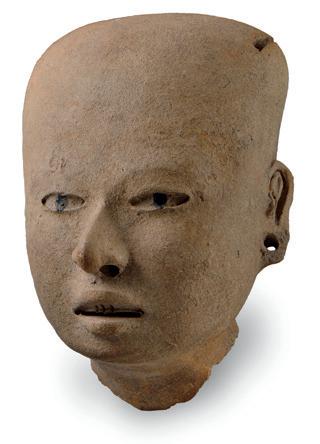
Heads, fragments of anthropomorphic clay sculptures




Remojadas tradition
Classic. 200-900 A.D.
Central Veracruz
Modeled clay
53
Museo Amparo / The Pre-Columbian Collection
GALLERY 3
HEAD
A peculiar form of portraiture aimed at exalting governors was practiced during the Olmec period, almost exclusively along the Gulf Coast. It consisted of disembodied heads carved out of stone, which were placed directly on the ground. The most famous examples are the colossal heads of San Lorenzo and La Venta, but smaller examples have been found in the Balsas River basin and along the Guatemalan Coast. The piece in this collection could be from either of these two regions; petrological analysis would determine which one.
FACES AND MASKS
Masks were used in all Mesoamerican cultures, often in dances and religious ceremonies, and sometimes even in comedies and farces reminiscent of Western Classical antiquity. Masks for acting or dancing were made of light, perishable materials such as wood, straw or paper. The only masks that have survived to this day are funerary masks, mainly in stone, with a few examples in clay. These masks seem to be linked to the idea of preserving part of an individual’s identity or soul at the time of cremation or burial.
54
Gallery 3 / Bodies, Faces, People
Society and Customs
Like all great ancient civilizations, Mesoamerican society was founded on an agriculture capable of producing surpluses on a consistent basis. Despite the lack of animal fertilizer or plows, Mesoamerican agriculture was intensive and complex. In fact, it was one of the most highly developed agricultural systems in antiquity, in terms of leveling and shaping arable lands, irrigation, and the use of crop rotation and intercropping techniques. Three of the most important crops in Mesoamerica lent themselves very well to being grown together in a single field: corn, beans, and squash.
The Mesoamerican economy was complemented by fishing and hunting, a wide variety of craft activities, and intensive trade. Certain tasks, such as fishing and collecting salt, became specialized activities, as most crafts did. The most widespread of these was pottery, with many individuals working full time as potters. Such specialization led to entire districts being devoted to a single occupation.
Urbanization and population concentration became widespread in Mesoamerica. Urban conglomerations, many of which have pervived throughout history, led to the development of social stratification between the producers who paid tribute and the leaders who received it. Society also became more diversified in terms of ethnic origin, lineage, experience, military merits, and other criteria such as age, gender, and so forth.
55 Museo Amparo / The Pre-Columbian Collection
GALLERY 4
1. Tláloc, the god of Rain
One of the oldest Mesoamerican deities is the god of Rain, commonly known by his Nahuatl name, Tláloc. Worship of this god may have begun around 1000 b.c., but the clearest images, similar to those we see in the codices, appeared for the first time around 200 a d in Teotihuacán.

Tláloc is identified by the rings around his eyes, his long fangs, and droplets or seeds emerging from his mouth. He lives in mountains, holding or releasing water, and is responsible for mist, clouds, and storms.
Teotihuacan
Early Classic. 200-600 A.D.
City of Teotihuacán
Mural painting, fresco-secco on stucco
56
The god Tláloc, mural painting fragment
Gallery 4 / Society and Customs
WORK AND SUSTENANCE
Perhaps sixty to seventy percent of the total population of Mesoamerica was devoted to agriculture, meaning that agricultural production was sufficient to feed the farming communities, as well as the third of the population that did not work at cultivating the land—mainly artisans, warriors, and the priestly and governing classes of the nobility. This system was formed over a period of several centuries. The domestication of plants began around the year 5000 b.c.; sedentary life was established between 3000 and 2000 b c ; and social stratification began between 1000 and 500 b.c.
HUNTING
Hunting never lost its significance as a complementary economic activity to agriculture. Dart throwers, bows and arrows, and different kinds of traps were used to hunt deer, hares, ducks, and many other kinds of game. Fishing was always another important activity.
2. Duck shaped vessel
Many works by the craftsmen of Tlatilco depicted life in the lake region of the Valley of Mexico, with fish and ducks prominently featured. Ducks must have represented a significant part of the local diet, judging by the importance given to their image in painting and ceramics, and the wide variety of duck hunting techniques developed.
57 Museo Amparo / The Pre-Columbian Collection
GALLERY 4
Duck shaped vessel
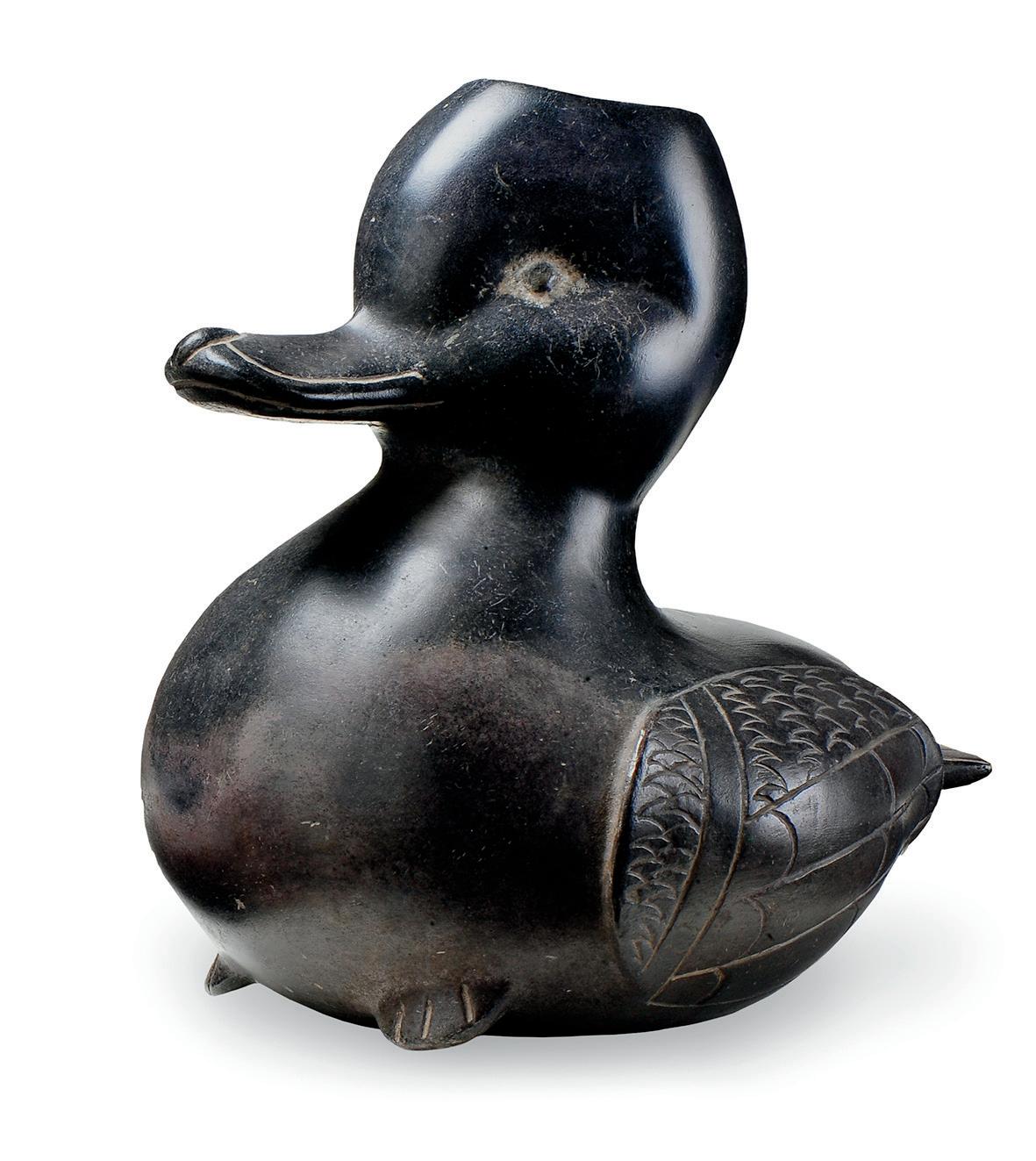
Tlatilco
Middle Preclassic.
1200-800 B.C.
Tlatilco, Valley of Mexico
Modeled clay; black coating with intense burnishing
AGRICULTURE
Corn was first domesticated in Mexico. Beginning with the wild plant which had flexible spikes and small seeds, selection work carried out by gatherers in different parts of Mexico, including the Tehuacán Valley, the Huasteca, and the Balsas River basin, resulted in the robust ears of corn we know today. Dozens of varieties of different sizes and colors were developed over time, while beans, squash, amaranth, tomatoes, avocados, guavas, and other fruits rounded out the plant-based diet.
3. Man holding a bottle gourd
Squashes and gourds were used in their entirety, even the shells, which were emptied and then sealed to use as floats. But the seeds constituted the most highly valued part of this plant, and were used to prepare something similar to a pipián sauce for daily meals. Peanuts were another plant product that originated in Mesoamerica, also used to make sauces.
58
Gallery 4 / Society and Customs
Man holding a bottle gourd and wearing a mask on his head
Nahua. Mexica style
Late Postclassic. 1200-1521 A.D. Valley of Mexico
Sculpted stone
DOMESTIC ANIMALS
There was a vast difference between ancient Mexico and other parts of the world in terms of the kinds of domesticable animals found in the region: there were no pigs, goats, sheep, chickens, horses, or cows. The dog was the only truly domesticated animal, probably during the Pleistocene period, meaning that the original occupants of the Americas already coexisted with this animal in their daily life. There were at least three dog breeds in ancient Mexico, the best known of which is the Xoloitzcuintle, or Mexican Hairless.

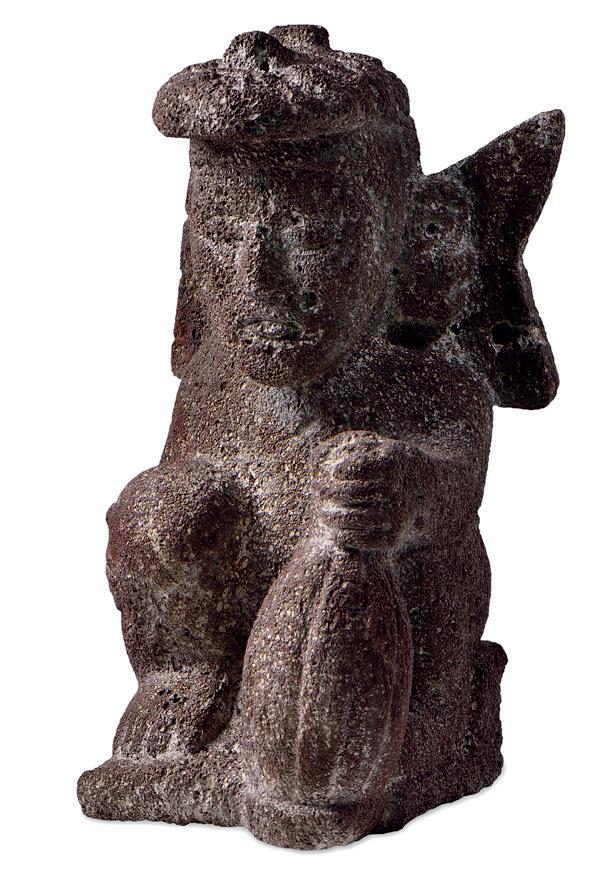
Dog with a corn cob between its teeth
Shaft tomb tradition. Comala style
Late Preclassic-Early Classic. 300 B.C.-600 A.D.
Colima
Modeled, incised and burnished clay
59
/
Museo Amparo
The Pre-Columbian Collection
GALLERY 4
4. Reclining dog shaped vessel
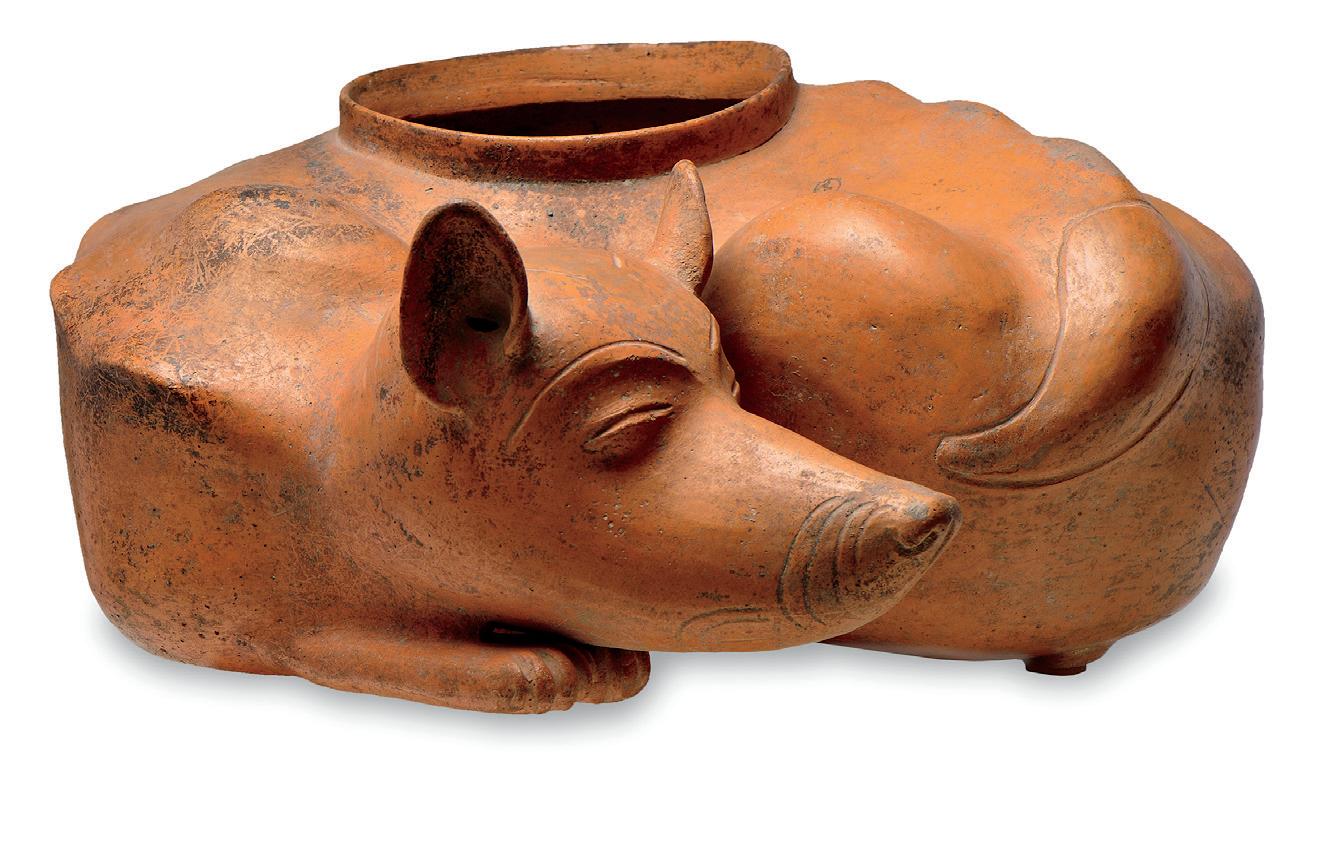
This beautiful vessel is an example of the highest quality ceramic types in Mesoamerica: the so-called Thin Orange Ware, produced in Teotihuacán and nearby communities such as Cholula that were linked to Teotihuacán’s artisanal production and commercial systems. Thin Orange Ware, is surprisingly light compared to other types of ceramics, allowing the modelling of a variety of shapes with very thin walls.
But the most striking thing here is the dog. It is easy to imagine one like this curled up at the entrance to any residential complex in Teotihuacán. Dogs were found in houses and on the streets, and were part of urban and domestic life. The custom and presence of this animal in Teotihuacán could be compared to the dogs in Pompeii, for instance.
Reclining dog shaped vessel
Teotihuacan
Early Classic. 200-600 A.D.
City of Teotihuacán
Modeled and smoothed thin orange paste
60
Gallery 4 / Society and Customs
VILLAGE LIFE
Villages were the first sign of sedentary life in Mesoamerica. By 3000 b.c., the old temporary gathering camps were transforming into permanent agricultural settlements. Such villages were the source of many cultural patterns that we now identify as typical to Mesoamerica. Much of the region’s mythology and several religious practices likely developed during this phase.
The first urban centers were established around 1000 b.c.—perhaps a little earlier or later, depending on the region. Cities with streets, squares, districts, and avenues did not appear until 500 b.c., with the foundation of sites such as Cuicuilco and Monte Albán. From this point on, areas of villages and rural settlements persisted, but in coexistence with urban agglomerations.
5. Vessel in the shape of a seated water carrier
When studying the cultures of the past, it is important to consider how they provided for certain basic needs that many of us take for granted today: how they obtained salt or disposed waste, for example, but above all, how they obtained water.
Drinking water could sometimes be found near residential areas. For example, homes in Teotihuacán had wells in the patios, so a person only had to take a few steps to get water. And in Tenochtitlan, jugs of drinking water were distributed by canoes that circulated along the canals. But in many places, people had to haul jugs of water on their backs, from rivers or dams.
61 Museo Amparo / The Pre-Columbian Collection
GALLERY 4
Vessel in the shape of a seated water carrier Shaft tomb tradition

Late Preclassic-Early Classic. 300 B.C.-600 A.D.
Jalisco
Modeled and burnished black clay
TOOLS
The efficiency of Mesoamerican technology is best demonstrated by the quality and complexity of the work processes and the skill and coordination of the work force, rather than by the tools used. There were no carts, pulleys, scissors, or mills; people were not familiar with iron. Copper was used on a very limited basis, only for sewing needles and fishhooks. When it came to tools, the technology was Neolithic.
Some copper and bronze hoes and spades have been found, especially in Michoacán, but it is unclear whether they date from Pre-Columbian times or from the beginning of the Colonial period. Most axes were stone and were used to cut down trees. Battleaxes were usually copper, and were especially common in Michoacán and Guerrero.
62
Gallery 4 / Society and Customs
LIVES, TRADES, AND TASKS
The notion of a self-sufficient community of farmers living in harmony and periodically visiting a religious center bears no resemblance to the truth. Social stratification began to develop in Mesoamerica at almost the same time that labor specialization and a more sedentary lifestyle gave rise to new fields of knowledge and trades. There were many cities scattered around most regions, so urban life was highly characteristic of Mesoamerican culture.
LIFE CYCLE
Like other ancient civilizations, Mesoamerican society suffered from high infant mortality rates. The children of artisans and farmers would spend their early years close to their parents, while noble children would have nursemaids or servants. Young adulthood came at an early age; by fifteen, young people would have had military training and could marry. They would also know the trade they were destined to practice, based on their gender and social standing. The offspring of noble families likely remained in the palaces and temples for several more years in order to complete their religious and academic education, which was much more complex and specialized than that received by commoners.
Male and female adults could be either married or widowed, but they always belonged to a given lineage and district, which determined their work and religious lives. Only priests, monks and small groups of nuns were exempt from this rule, devoting their entire lives to the temples.
63 Museo Amparo / The Pre-Columbian Collection
GALLERY 4
6. Female figure
These two figures from the middle Balsas River basin belong to the Xochipala tradition, and have been dated to around 1000 b.c. They are impressive for their realism, representing an adult man and woman, likely for burying with the mortal remains of two deceased individuals. Few clear indications of indigenous notions of beauty have been found, but these firm bodies with strong legs, slender necks and serene expressions must have represented an ideal image of physical wellbeing and maturity.
Standing female figure

Xochipala tradition
Early Preclassic-Middle Preclassic. 1000-500 B.C.
Middle Balsas River basin
Modeled clay with pastillage
64
Gallery 4 / Society and Customs
Seated male figure Xochipala tradition

Early Preclassic-Middle Preclassic. 1000-500 B.C. Middle Balsas River basin Modeled clay with pastillage
HIERARCHIES
The pyramid is a good metaphor for the Pre-Columbian social structure: a broad base of workers, and above them, a series of much smaller classes that enjoyed an elevated economic position. At the top would be a figure with sacred attributes. In some cases, his feet were not allowed to touch the ground; in certain realms, it was prohibited to look upon his face. This was the emperor, the king, the all-powerful monarch; generally a man, although in the Mixtec region there were as many female rulers as there were males.
65 Museo
/
Amparo
The Pre-Columbian Collection
GALLERY 4
7. Scepter
The scepter was one of the symbols of royal power in Mesoamerica, apparently with particular importance among the Olmec and the Maya. Scepters often bore images alluding to the owner’s ancestors, suggesting that part of their power was thought to be present in these signs of authority. The scepter displayed here comes from the Balsas River basin and could form part of the group of objects marking a transition between Olmec-type expressions and local practices such as the so-called Mezcala tradition.
Scepter with human head

Mezcala tradition
Late Preclassic-Late Classic. 500 B.C.-900 A.D.
Middle Balsas River basin, probably
Carved calcite covered with a stucco-like material
66
Gallery 4 / Society and Customs
8. Anthropomorphic vessel in the shape of a hunchback Marginalized and ostracized by other individuals, excluded from any family group or lineage, dwarves and hunchbacks were bought and sold as curiosities or as entertainment for the court. Their personal situation was very sad, but their position in the court and in palace life offered them certain comforts and privileges.
Anthropomorphic vessel in the shape of a hunchback
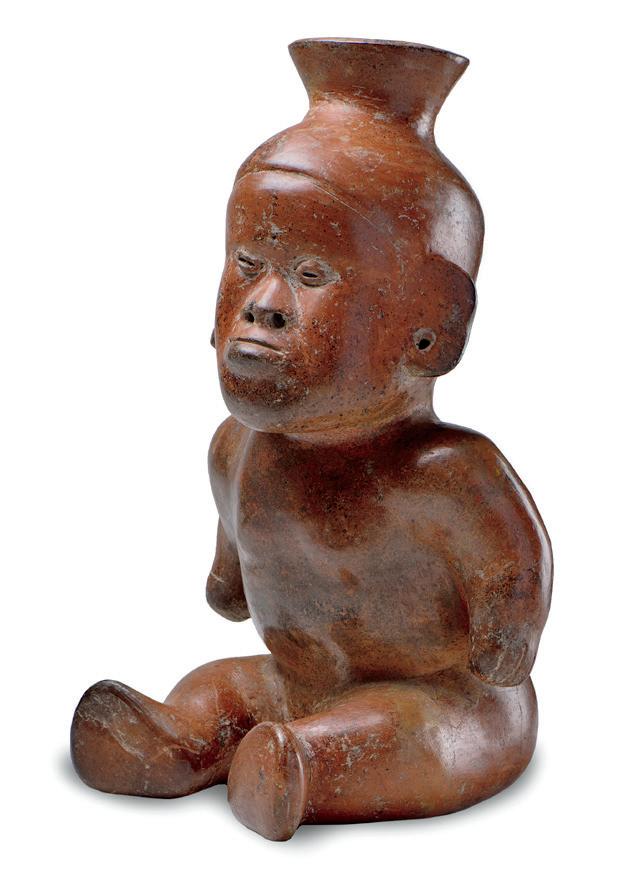
Western Mexico
Early Classic. 200-600 A.D. Colima
Modeled and intensely burnished clay
ARTISTIC TRADES
The wealthy Mesoamerican courts subsidized a specialized artistic production that was a great source of pride and helped shape the identities of feudal estates and empires. Cities had many districts of artists working in specialized trades. There is solid archaeological and documentary evidence that ethnic groups with experience in given artistic specialties would emigrate and apply for residence in the most prosperous cities, where they knew their work would be in high demand and that they would find a steady market for their products. The most talented artists were invited to work directly for the king and for those close to him, leading to the establishment of palace workshops and a class of court artists.
67 Museo Amparo / The Pre-Columbian Collection
GALLERY 4
9. Dance-battle scene between deities
Mural painting was one of the most widely practiced artistic activities in Mesoamerica, beginning in the Preclassic period. Given the size of Teotihuacán and the many masonry buildings found there, this was by far the city with the greatest number of mural paintings. Many square meters of paintings have been conserved and can be seen to this day, either in the city buildings that have been explored thus far, or in samples that have been removed from the walls and incorporated into different collections and museums.
By introducing pigments such as ferrous oxide, which produces an intense red background color, and nopal resin as a binding agent, the painters of Teotihuacán created incredibly rich iconographic programs. The fragment exhibited here was found on the lower part of a monastery wall and represents two gods associated with military attributes engaging in a kind of dance. This is one of the most remarkable and best preserved examples of the chromatic wealth of the mural paintings of Teotihuacán.
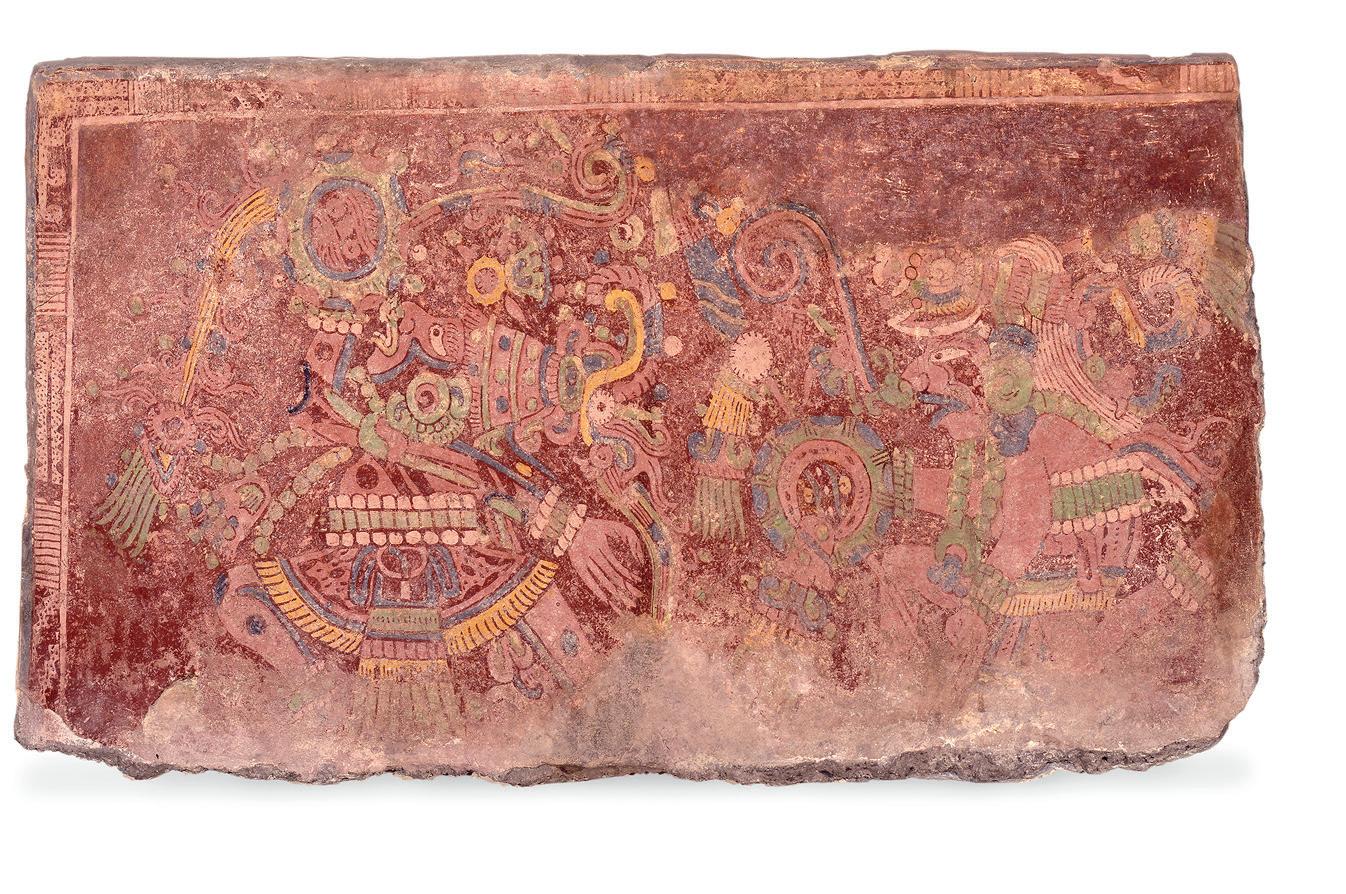
68
Gallery 4 / Society and Customs
(Previous page)
Dance-battle scene between deities
Teotihuacan
Early Classic. 200-600 A.C. City of Teotihuacán
Mural painting, fresco-secco on stucco
10. Miniature butterfly chest plate
Turquoise was one of the most prized stones in Mesoamerican courts. It is difficult to find in large blocks and fragments easily when working with it. For this reason, turquoise work was nearly always performed using mosaic techniques. Tiny, irregular fragments of stone were used to cover prepared surfaces of other materials, such as gold, bone or wood. This pectoral was made with a wooden support, some kind of resin, and finally the turquoise fragments. It seems to be a stylized butterfly, a symbol that was used by warriors since the time of the city of Tula.

Miniature butterfly chest plate with gemstone mosaic Mixteca-Puebla tradition
Late Postclassic.
1200-1521 A.D.
Central Mexico Plateau Wood with gemstone mosaic
69
Museo Amparo / The Pre-Columbian Collection
GALLERY 4
CLOTHING AND BODY ORNAMENTATION
We are a long way from comprehending the incredible wealth and complexity of Pre-Columbian clothing and personal ornamentation. Male and female attire was made from cotton textiles woven on backstrap looms, although poorer people tended to use rougher fibers. Fabrics for use by the nobility—governors, priests and wealthy people—had varied textures, colors and designs. Brocade was common, but there is also evidence of sewing and embroidery. Rabbit fur and feathers would sometimes be added to the fabric.
Clothing was only one aspect of body decoration. Other adornments included rings or cords around wrists and ankles, pectorals, necklaces, jewelry for ears and nose. Different coiffures distinguished marriageable women from married women, brave warriors from inexperienced young men, great captains from common soldiers. Such coiffures would be completed with ribbons, skins, helmets, and magnificent feathered headdresses. The most highly valued feathers were the quetzal’s long, green, brilliant plumes, but many others were also used; eagle feathers, for example, were valued for their religious symbolism linked to the sun.
11. Richly attired nobleman
Some small Mayan ceramic sculptures, especially those from the Jaina Island, were striking for their realism, and the artisans seem to have not wanted to omit a single detail of the clothing and physical appearance of the individuals depicted in these images, which would accompany their remains after death.
The variety of garments and ornaments we see in the figures is related to how different social criteria bestowed individuals with specific physical markings.
70
Gallery 4 / Society and Customs
Richly attired nobleman

Maya
Late Classic. 600-909 A.D.
Jaina Island, Campeche
Modeled clay with pastillage and painted incisions
71
Museo Amparo / The Pre-Columbian Collection
GALLERY 4
12. Bezotes
The old Spanish word bezote is still commonly used today to describe these lip ornaments. Such pieces were worn throughout Mesoamerica and had a strong hierarchical significance. Only members of the nobility could use them, but they also varied greatly in terms of size and quality of material, depending on the wearer’s social standing.
The bezotes seen here are relatively small—much larger ones also existed—and are made out of obsidian, which had some value but was not considered to be a particularly luxurious material. For example, a gold bezote with turquoise incrustations could only be used by a governor or someone of similarly noble standing. One of the imperial bezotes described in Nahua source materials was made of rock crystal with a bluebird feather inside it.

To wear a bezote, it was inserted into a piercing beneath the lower lip. The wings served to hold the piece in place and were in contact with the gums, while the protruding part—which was usually cylindrical—emerged through the piercing, pulling the lip slightly downwards.
Bezotes
Carved obsidian, polished by abrading



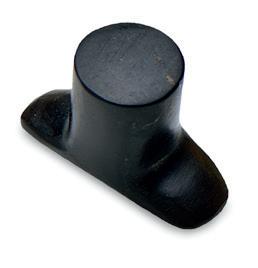


72
Gallery 4 / Society and Customs
War wasn’t absent in any Mesoamerican period; there were rather long stretches of stability, lasting several centuries, and critical periods of intensive military activity, as the period from 600 to 900 a d , and more particularly towards the end of the ninth century. This long crisis was the result of the fracturing of a highly centralized system in which one large metropolis, Teotihuacán, controlled the major commercial routes and influenced the politics of different regions. Emerging cities such as Tajín and Xochicalco competed for control over different routes and areas of influence, resulting in a combative environment, especially on the Central Plateau. Around the year 800, following a period of great prosperity, Mayan feudal estates in the lowlands—Petén, the Usumacinta River basin, the Motagua River—entered into a bellicose cycle that led to their mutual destruction.
During the final phase of Mesoamerican history, war had become routine, and military symbols appeared on the main palaces and temples of the cities, especially among the Nahuas of the Central Plateau.
It is in part due to this climate of constant warfare that the Spaniards arrived to find a panorama of entrenched rivalries, and many feudal estates willing to become their allies.
73 Museo Amparo / The Pre-Columbian Collection WAR
GALLERY 4
13. Olmec head
This is the head of a larger sculpture that broke into pieces. As such, it is not a true “Olmec head”—not one of the famed colossal heads from the Olmec tradition. It must have originally been part of a full-body sculpture, and judging by other known examples of Olmec art, it would have likely been a seated figure. The style corresponds to that of the Olmecs of the Gulf of Mexico. In several Olmec sites along the Gulf Coast, there are indications of violent destruction of images of governors. This may have been at the hands of enemies from other settlements, or by the local population. In any case, it was a violent act representing the symbolic suppression of the power of a given lineage or individual.

Head of an Olmec sculpture
Olmec
Middle Preclassic.
1000-300 B.C.
Southern Veracruz or Tabasco Carved stone (possibly basalt)
74
Gallery 4 / Society and Customs
Language and Writing
The cultures of Mesoamerica developed different ways of registering historical events in order to verify royal genealogies, to calculate and record astronomical events, and to chronicle political or military history. The largest body of inscriptions comes from the Mayan region. There is no doubt that writing developed most extensively among the Maya.
However, the earliest known written inscription was made during the Olmec phase along the Gulf Coast, followed by some major achievements in writing in Oaxaca, Southern Veracruz, and the Isthmus of Tehuantepec.
Teotihuacan, Zapotec and Mixtec people, all developed rich iconographies in their paintings and reliefs, but they preferred a pictographic language based on narrative scenes, limiting the use of writing to calendrical signs, place names, and proper names.
75 Museo Amparo / The Pre-Columbian Collection
GALLERY 5
OAXACAN RECORD-KEEPING SYSTEMS
Not long after the emergence of writing along the Gulf Coast, inscriptions were used in Oaxaca to record phrases and calendrical dates. But unlike the Mayan region, where writing thrived for years, Oaxacan systems assigned a great deal of importance to figurative and iconographic representations that were not writing per se. These narrative scenes alluded to ambassadorships, acts of government, and conquests, as well as mythical episodes. Written elements generally provided the names and dates associated with the events.

76
Gallery 5 / Language and Writing
1. Mixtec lintel
The record on this Mixtec lintel from the Late Postclassic period is similar to a codex. At the center of the scene there is a large year symbol that appears as a lightning bolt or spearhead inserted into a trapezoidal form. It indicates the year 9-Rabbit, given that the animal’s head appears above the numeral formed by a bar (with a value of five) and four dots. Four seated figures are seen presenting an equal number of supernatural beings, as if in offering, and there are dates next to each of them.
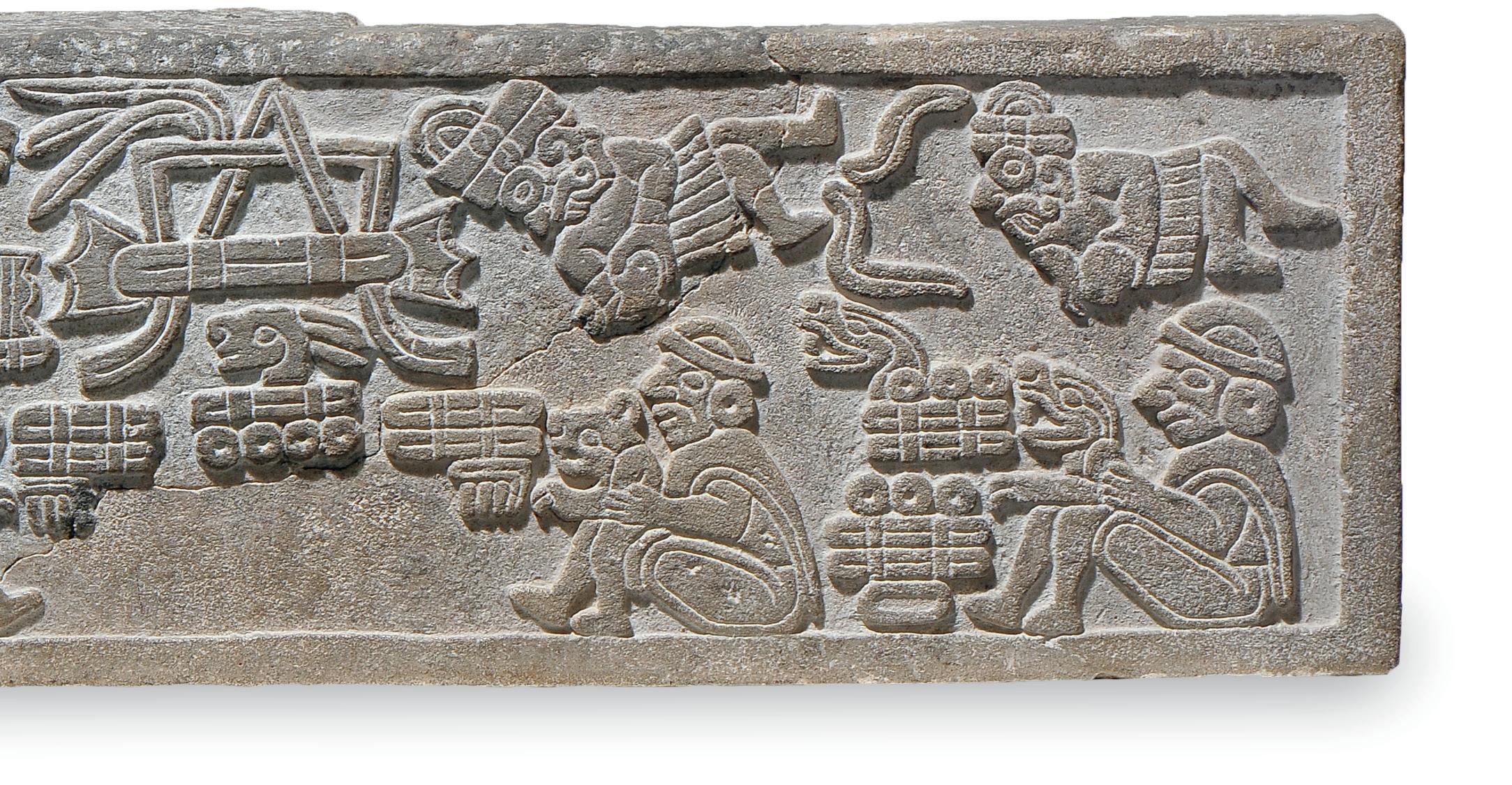
The upper part of the lintel shows four floating or traveling representations of the Mixtec god of Rain, named Dzahui.
Mixtec lintel depicting the rain gods and their possible ritual functionaries
Mixtec
Late Postclassic.
1200-1521 A.D.
Mixtec region
Carved stone
77 Museo Amparo /
Collection
The Pre-Columbian
GALLERY 5
It is no exaggeration to state that Mayan writing was Mesoamerica’s greatest and most complete writing system, and the only one to develop a way to record phrases as they were pronounced out loud. The Maya produced texts such as short tales, prayers, declarations about the divinity of governors, and descriptions of political or astronomical events.
Many Mayan inscriptions were made in stone and stucco, but there were also a number of texts written on ceramics and in codices.
2. Chocholá style bowl

This clay bowl was made around the seventh century a.d., during the Late Classic which was a period of great splendor among the Maya. The piece comes from the northwestern part of the Yucatán Peninsula. Richly decorated bowls such as this one were exclusively for the use of governors and other members of the upper nobility, who drank chocolate or the maize drink atole out of them. According to epigraphical analysis, the text inscribed along the upper rim is loosely translated as “The clay bowl of Sajal Tik’anil Mo’ K’uk’u’m has been fabricated and consecrated.” Sajal was a term applied to a local governor.
Chocholá style bowl
Maya. Chocholá style
Late Classic. 600-909 A.D. Puuc region, north of the Yucatán Peninsula, probably Oxkintok
Modeled and incised clay, with engobes and pre-firing incisions
78 MAYAN
WRITING
Gallery 5 / Language and Writing
3. Tripod vase with court scene
The incredible polychromy of many Mayan ceramic vases was possible thanks to the technique of pre-fired painting, which added a notable gloss and resistance to their colors. Artisans on the Central Plateau would learn these techniques over time.
This vessel belonged to a governor, whose image it bears: he is the only figure shown seated and facing forward, with his head turned to the left to address a lower ranking interlocutor, as dictated by Mayan convention. The person appearing before the sovereign is most likely a nobleman from the provinces who owed him obedience, and showed his respect by presenting a gift of cotton blankets. There are two other figures on the vessel, which may be two priests, or perhaps a priest wearing a white turban and a government officer.
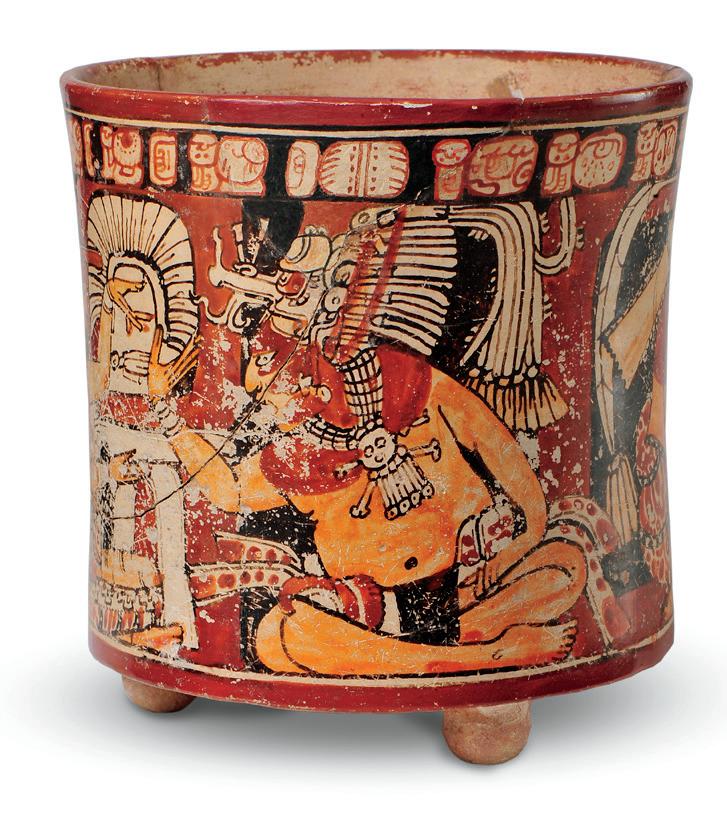
The inscription is not a coherent phrase; rather, it seems to be a litany of hierarchical and sacred attributes alluding to the governor and perhaps to other individuals. Among other things it states: “The one in yellow, the reader, the scribe, night, he of the squash, Natzin, the accountant, […] he of water, mother of the earth, […] he of the bird of prey, the reader, son of woman, wise man, he of death, […] he of water.”
Tripod vase with court scene
Maya Late Classic. 600-909 A.D. Petén region
Modeled and coiled clay, with engobe and polychromy
79 Museo
/
Amparo
The Pre-Columbian Collection
GALLERY 5
4. Stone door jamb
One example of Mayan writing practice, the fluency of scribes and their interest in recording what priests and governors told them, is this relief that was probably one of two door jambs alongside the entrance to a room. However, the long inscription on this monument is simply written proof of the date when decoration of the room was completed.

In general terms, the text states that the placement of the room’s decorations was completed during the month of September of the year 750 (according to our calendar). It also names the room’s owner as Piip and states that he was a dignitary with the title of sajal, meaning that he was a kind of local chief subjected to a king.
Stone door jamb with hieroglyphic inscriptions
Maya Late Classic. 600-909 A.D.
Puuc region, northeast of the Yucatán Peninsula
Carved stone
80
Gallery 5 / Language and Writing
Art, Form, Expression
Imagine for a moment that we are in the main square of a Mesoamerican city, as if we had traveled back in time to witness a festive day. We observe the vast space of the plaza, where the ground is level, smooth, and clean. Several paved roads converge upon the open space, and drainage gutters run parallel to one of them. Platforms with steps encircle the square, and temples and palaces stand atop the platforms. Some walls are covered with polished stucco; others are painted bright red. The sound of drums can be heard coming from different temples, all playing precisely the same beat. There is a chorus of voices, deep and slow, emanating from the monasteries next to the temples. The rippling white background formed by the pilgrims’ cloaks is interrupted by the endless red of the tunics, capes, and tilmas worn by members of the nobility and city authorities. Feathers on the headdresses, many of them bright green, also flutter in the breeze. Warriors wear their gala shields, decorated with blue and yellow macaw feathers. Climbing the staircase at our backs, we come to a magnificent portico flanked by sculptures, leading into a palace. Once inside, we are surprised by the opulent paintings of birds, alligators, stars and battles. In one room we see wicker stools, rabbit-fur mantles, pillows, ceramic vessels with fantastic shapes, and become again surprised by the green jade pectoral worn by a solemn man at our side. The unparalleled wealth of Mesoamerican artistic expression speaks to us of that ancient civilization’s great force and personality.
81 Museo Amparo / The Pre-Columbian Collection
GALLERY 6
1. Reclining feline
The entrances to many Mesoamerican temples and palaces were flanked by sculptures, usually in pairs. They sometimes acted as sentinels or standard-bearers, and each image would be linked to the symbolic significance of the building it guarded.
One of the most important images in Mesoamerican religious thought and iconography was the jaguar: messenger from the mountain, dweller in the dark world, related to the water gods. During the final phase of Mesoamerican history, the jaguar also became an emblem of war. The jaguar’s cosmic opponent and complement was the eagle.

Reclining feline
Nahua. Styles contemporary to the Mexica Late Postclassic.
1345-1521 A.D.
Valley of Mexico, PueblaTlaxcala
Carved and polished stone
82
Gallery 6 / Art, Form, Expression
ARCHITECTURE, SCULPTURE, PAINTING
There was a natural continuity in the different artistic languages that existed among the indigenous cultures of ancient Mexico. Sculpture and painting were indispensable elements of architecture, often combined on a single wall. A building’s symbolic meaning could frequently be discovered by observing the architecture as a whole, along with its sculpted or painted images. Mesoamerican structures and sculptures were nearly always painted, turning cities into vivid spectacles of color amid the jungles and valleys they occupied.
2. Panel with two characters seated on a throne dialoguing
In the many Mayan settlements that thrived in the humid, tropical lowlands during the Classic period, stucco techniques were often used to produce bas-relief images. This panel in particular was part of a group, along with another image shown in this gallery. They likely were part of a longer narrative, depicted in relief on the wall of a palace or temple.
The two figures are seated on a structure representing the concept of “Jaguar Mountain,” apparently the place of origin of women who went to be married in Yaxchilán. At least one of the two figures is a priest, identified by his cylindrical headdress. The two figures had comparable hierarchical positions, given that neither is seated higher than the other.
There is no doubt that the piece is from the Usumacinta River basin and belongs to the Late Classic period.
83 Museo Amparo / The Pre-Columbian Collection
GALLERY 6
Maya Late Classic. 600-909 A.D.
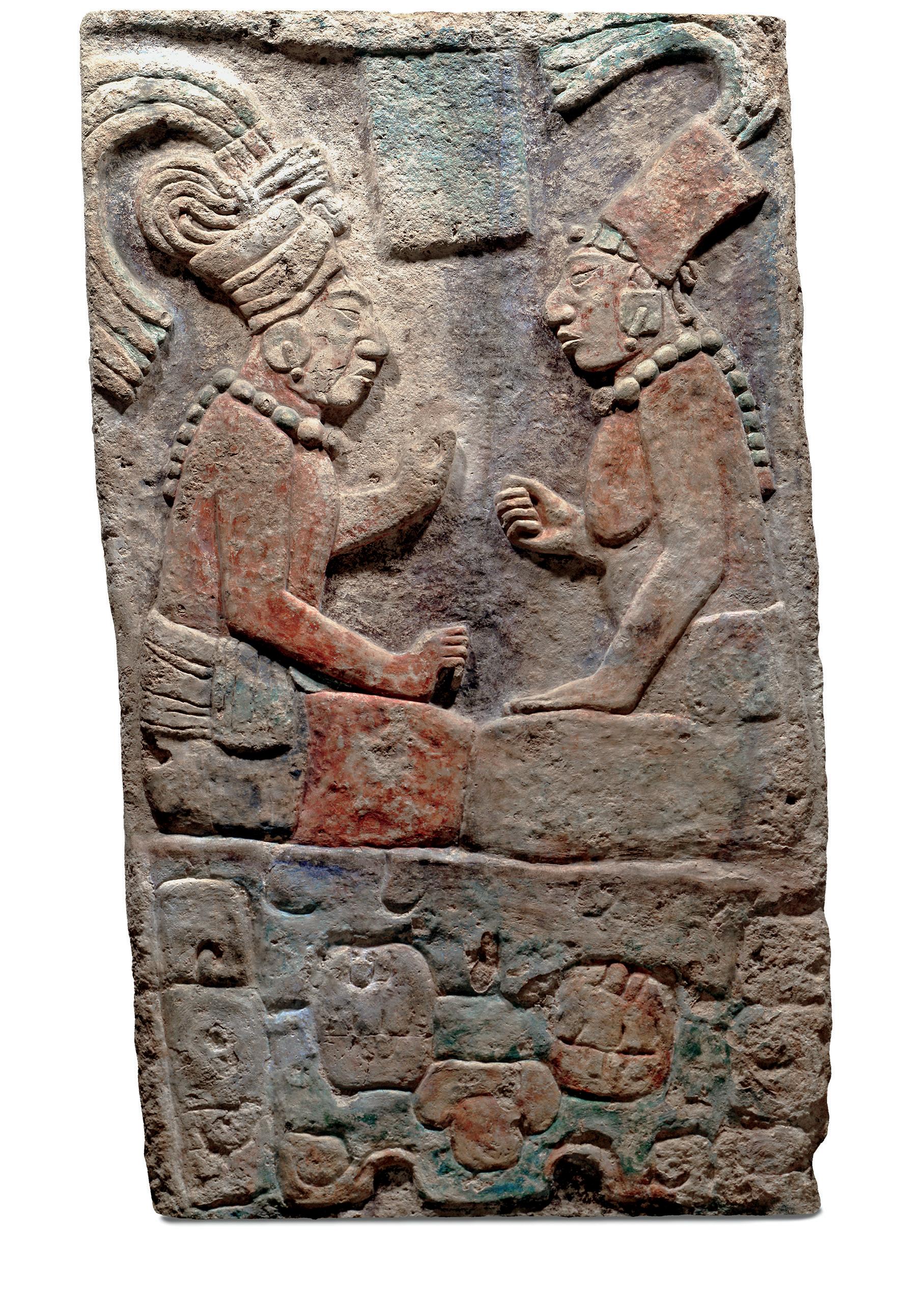
El Chicozapote, Usumacinta River basin, northeast from Yaxchilán
Modeled, incised and polychromed stucco
84
Panel with two characters seated on a throne dialoguing
Gallery 6 / Art, Form, Expression
3. Singing quetzal with speech scroll
Some of the crowning achievements in the history of Mesoamerican art were without a doubt, the mural paintings that decorated the city of Teotihuacán. The inhabitants of Teotihuacán established a language, a repertoire of themes and figures, even a color palette of their own. This gave a sense of of unity to the metropolis. From one ceremonial building to another, from monasteries to palaces, there was always a sense of profound harmony: the whole city had a single symbolic language.
Over the intense red color which predominated in Teotihuacán, obtained from hematite or ferrous oxide, other bright and even cheerful colors were painted to represent the god Tláloc, as well as flowers, felines, priests, and birds like the one seen in this fragment and in its twin on the opposing wall. Both birds are quetzals, which were highly valued by Mesoamerican cultures, and linked to the sacred force that gives life and makes plants grow, as well as to nobility and power.
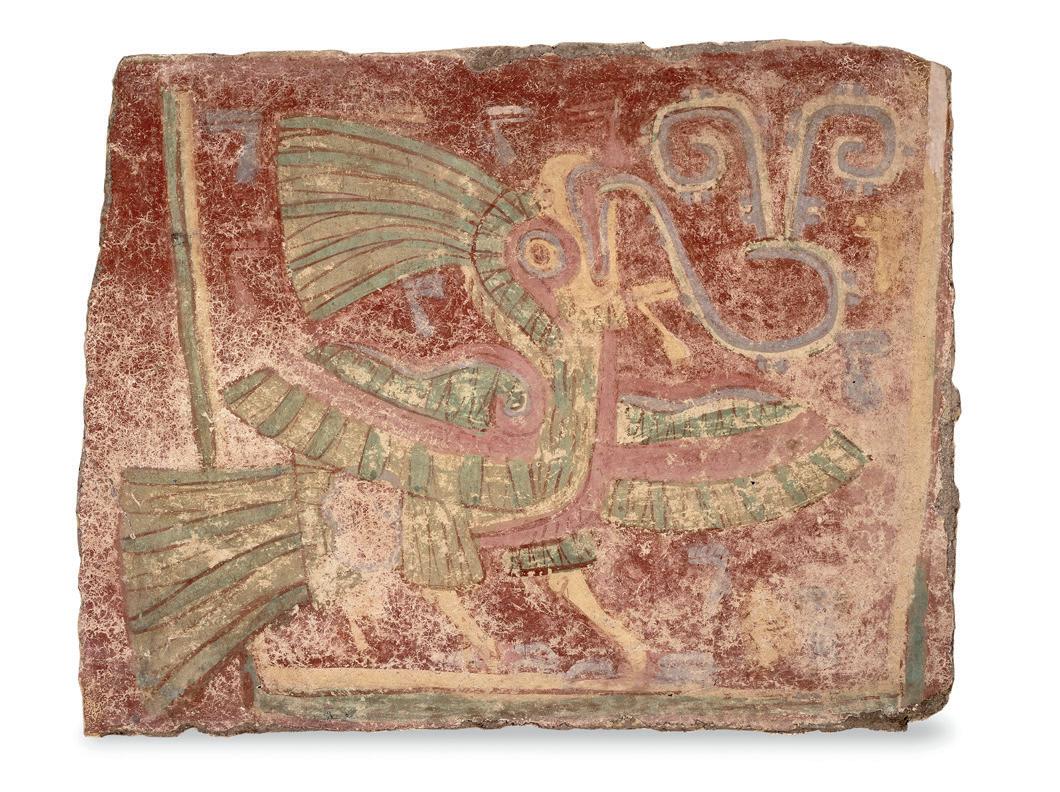
Teotihuacan
Early Classic. 200-600 A.D.
Techinantitla
Mural
85 Museo Amparo /
Pre-Columbian Collection
The
Singing quetzal with speech scroll, mural painting fragment
residential complex, city of Teotihuacán
painting, fresco-secco on stucco
GALLERY 6
DANCE
During the Colonial era, and as late as the seventeenth and eighteenth centuries, indigenous communities considered dance as an essential aspect of their religious practice. They danced in the atriums of Christian churches and hired dance teachers so they wouldn’t forget the steps. The quetzal feathers needed for the dance were passed down from parents to children. All this demonstrates the deep roots and cultural transcendence of Mesoamerican dance, especially in the ceremonial context.
Dances were often circular, and always performed in groups, following the rhythm of drums enriched with a few flutes and whistles, in a collective act that was essential for animating and thanking the gods, who moved up and down, also in circles, bearing energy, change and life.
MUSIC
The absence of musical notation in ancient Mexico meant that the old rhythms and musical pieces could not be preserved; this is an irremediable fact. Visiting an indigenous community today, or even a hundred years ago, would not provide much insight into ancient musical languages, because Spanish settlers rapidly began to introduce European instrumental repertoires, and Medieval or Renaissance rhythms and genres. Music was one of the cultural elements that changed most radically in Mesoamerica, beginning as far back as the 1520s. Certain rituals and dances—among communities such as the Mexicaneros or the Tepehuanos in the Western Sierra Madre, for example—provide some indication of what the ancient music might have been like: the incessant beat of a drum marking the dance steps, and a flute to organize the monotonous sound of the drum into cycles.
86
Gallery 6 / Art, Form, Expression
What still remains is the archaeological evidence of the instruments per se, many of them wind instruments: whistles, trumpets, flutes with one or several ducts. By playing them now, we can at least recover the tones available to Pre-Columbian musicians.
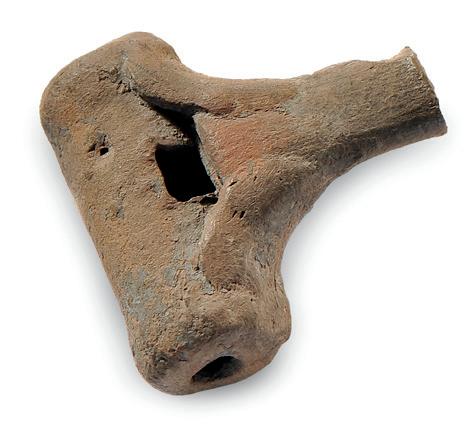
Whistling vessel with hydraulic mechanism
Nahua
Late Postclassic.
1200-1521 A.D.
Central Mexico Plateau, possibly
Modeled and perforated clay, with red and black engobes
Transverse flute
Nahua
Late Postclassic. 1200-1521
A.D.
Central Mexico Plateau
Modeled and perforated clay
Double whistle integrated in a zoomorphic effigy

Tlatilco
Middle Preclassic, Manantial phase. 1000-800 B.C.
Valley of Mexico
Modeled and polished clay
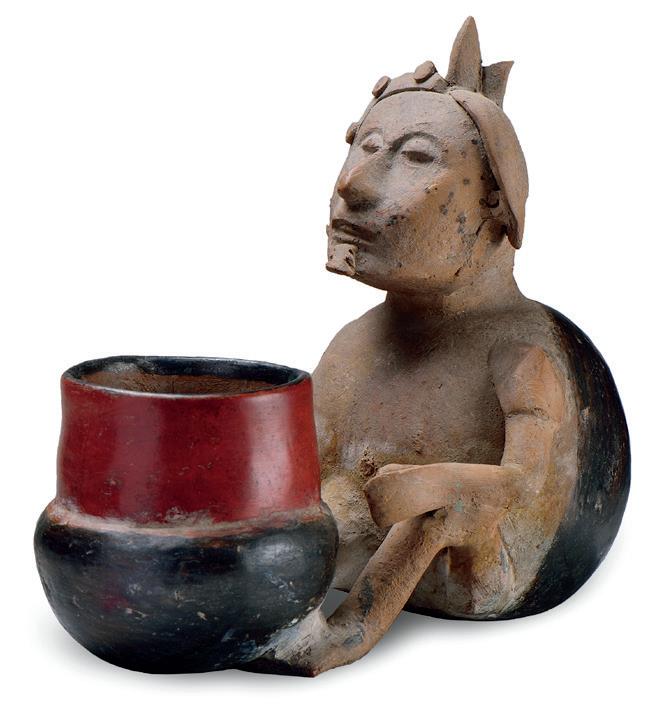
87
Museo Amparo / The Pre-Columbian Collection
GALLERY 6
CERAMICS
Perhaps no other ancient civilization possessed the enormous diversity of ceramics that Mesoamerica did. This becomes more evident when we consider the two main categories of this art form found in the region: ceramic vessels and sculptures. There were also numerous effigy vessels, which represented a synthesis of the two ceramic types, as well as terracotta masks and architectural sculptures.
Mass production using molds was carried out in many cities, particularly in Teotihuacán, Monte Albán, and Tenochtitlan. However, most of the highly original ceramic works from the Mesoamerican tradition were created by directly modeling individual pieces.
4. Globular pot
The simplest ceramic forms were created in response to universal needs common to all world civilizations, such as hauling water or cooking food, and tend to resemble each other closely. The two-handled pot was present throughout Mesoamerican history, and was normally used to cook beans, tomatoes, sauces, and other meals. A few utilitarian pots such as these would be included in funerary offerings, to ensure the nourishment of the souls of the deceased during their years of pilgrimage.
Modeled clay, with evidences of intensive use
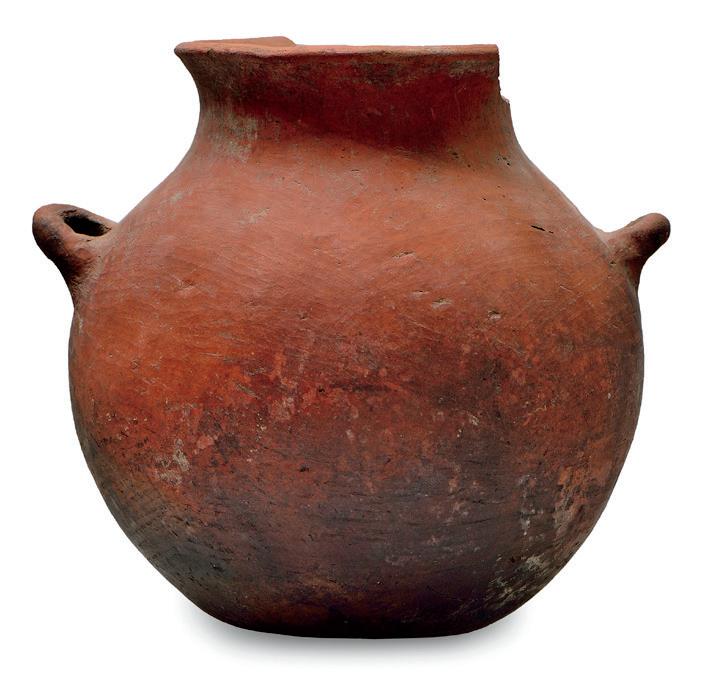
88
Globular pot with two handles
Gallery 6 / Art, Form, Expression
5. Large bottle with geometric decoration
The Preclassic period was a time of intense aesthetic and technological experimentation. Because of this, even relatively small early settlements such as Tlatilco produced a much greater diversity of ceramic types than many cities during the Classic period. The vessel with an upper handle that also served as a spout was one of these early inventions. This design fell into disuse later in Mesoamerican history.

Large bottle with geometric decoration
Tlatilco
Middle Preclassic. 1000-800 B.C. Valley of Mexico
Modeled and smoothed clay, red on beige slip
6. Bowl with cosmogram
Abstract and geometric decorations provided certain Mesoamerican pieces a universal quality which some might even call modern. In their aesthetic quest, Mesoamerican artists explored concepts such as symmetry, contrast, and sequence. Beyond the crosses, groupings of lines, and oscillations, the genius of these artists is a constant presence that lies in sharp contrast to the artifacts’ specific religious and historic purposes.
Bowl with cosmogram

Shaft tomb tradition. Lagunillas style
Late Preclassic-Early Classic. 300 B.C.-600 A.D.
Southern Nayarit
Modeled and polychromed clay
89 Museo
Amparo / The Pre-Columbian Collection
GALLERY 6
Jugs for holding and pouring liquids represented another ceramic form that developed simultaneously in different cultures. They were found in the final phase of Mesoamerican history, as seen in the codices and in a few surviving examples, such as this one.

Jug
Mixteca-Puebla tradition
Late Postclassic. 1200-1521 A.D.
Central Mexico Plateau Modeled and polychromed clay, intensively burnished
8. Tripod vessel
One can hardly refrain from calling a specimen such as this a masterpiece. This tripod vessel probably once had a lid, which has been lost over time. It comes from the Early Classic period, likely from somewhere along the Gulf of Mexico, although it could have been made in a district of Teotihuacán inhabited by people from the Gulf. The most remarkable feature of this piece is the somewhat anthropomorphic monkey that the artist placed inside the vessel before firing. Leaning with one hand on the floor, the monkey’s face is turned upward, looking at us as it shields its eyes from the light. The artist probably came up with this curious addition after reflecting on the effect of light suddenly entering the vessel when the lid was removed.
90
7. Jug
Gallery 6 / Art, Form, Expression
Tripod vessel with the effigy of a monkey looking upwards
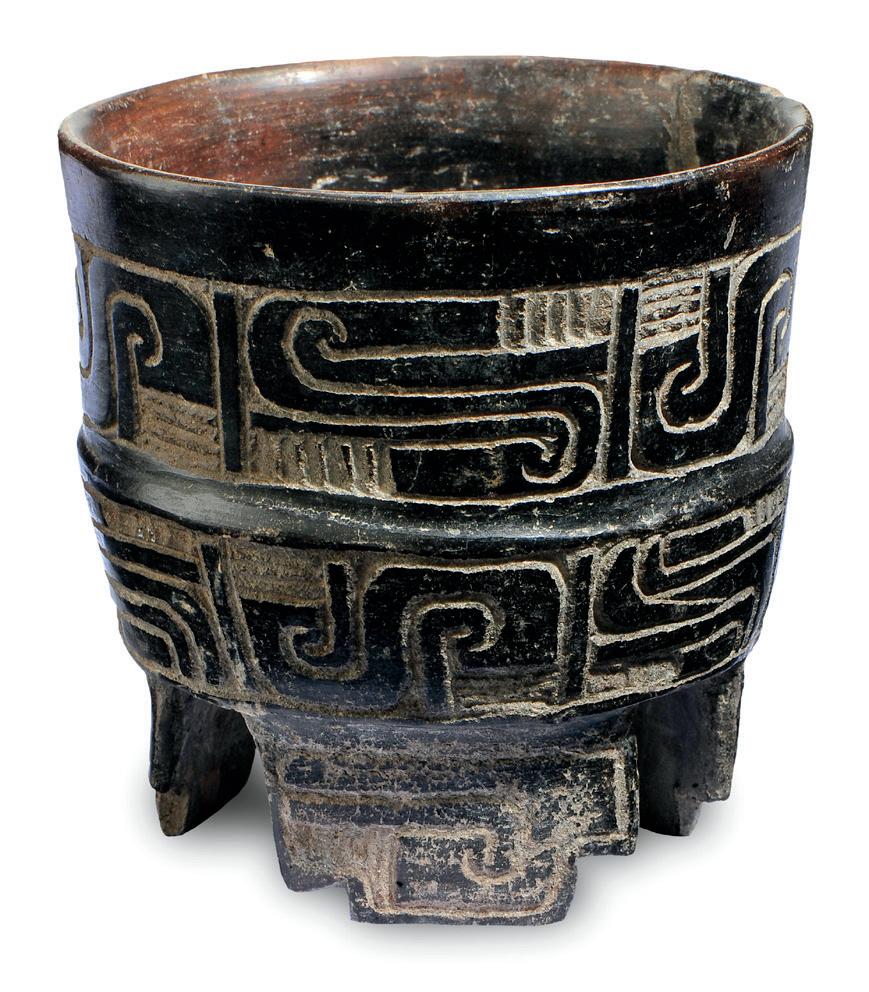

Central Veracruz. Teotihuacan influence period
Early Classic. 200-600 A.D. Modeled clay; molded feet; effigy affixed with pastillage
91
Museo Amparo / The Pre-Columbian Collection
GALLERY 6
Death
Like all civilizations throughout history, the people of ancient Mexico suffered with death. It is true that bravery in war was a key value, so warriors would always go into battle with aplomb. There was also a very clear awareness, rooted in the world view, of the need for death in order to ensure the continuity of life. But it is equally true that people were afraid to die, and mourned the deaths of their loved ones. And despite the sacredness of their mission, sacrificial victims would be forlorn and taciturn while awaiting death in captivity for days or even months. One way of counteracting their natural survival instinct was to administer drugs to the captives, to make them accept a fate that they logically found distressing.
Beliefs about the soul’s continued existence for four years following death, the idea that the vital spirits of the ancestors remained in their homes, and the social need to pay tribute to the dead, all resulted in a rich funerary culture.
92
GALLERY 7
1. Yoke with skulls
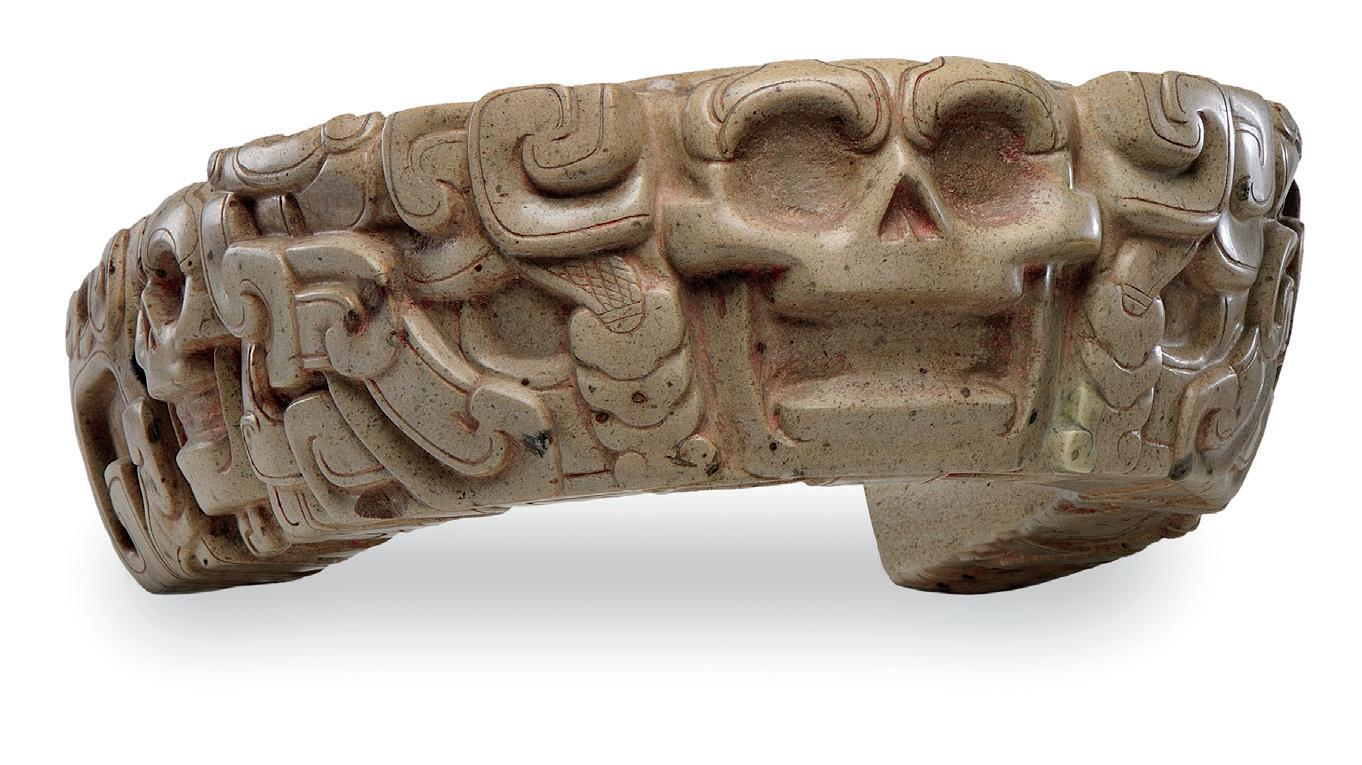
These pieces known as “yokes” have been associated with the ritual ballgame, although the connection is still hypothetical. What is clear is that they are funerary objects that have been found alongside bones and offerings, and were mainly produced during the Late Classic period. Given their style and regional distribution, they must have fallen within the orbit of the culture of El Tajín.
This yoke has three skulls, one on each side and one on the front, a series of interlacing lines, and two snakes with rattles.
Yoke with skulls
El Tajín culture
Classic. 200-900 A.D.
Veracruz
Sculpted and polished stone
93
Museo Amparo / The Pre-Columbian Collection
THE FACES OF DEATH
Mesoamerican art had different ways of representing death and the dead. In some cases, figures were simply depicted with closed eyes, meaning that they had recently died, but conserved all their features. There were also many representations of bodies in the process of losing their flesh and becoming skeletons.
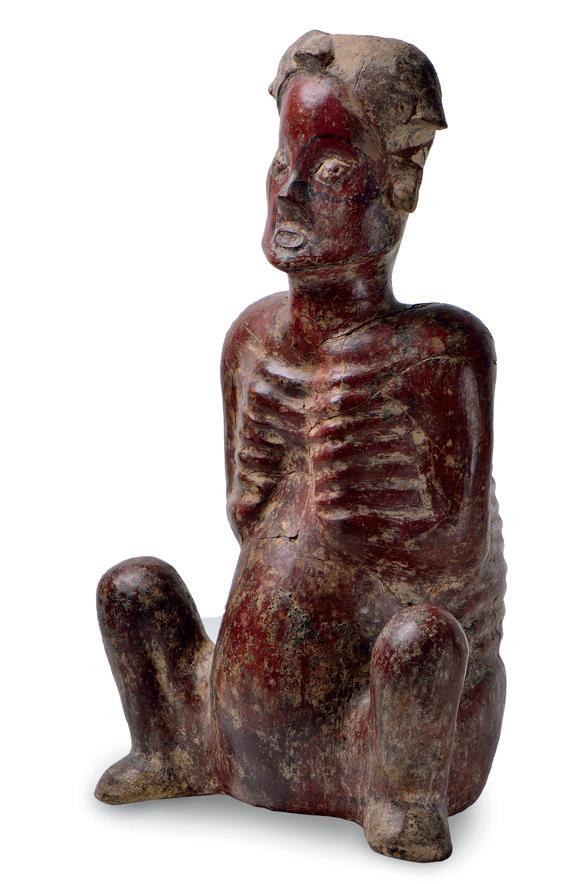
Skulls and skeletons were often represented in an animated state, as seen, for example, in representations of the gods of death, whose skeletal bodies sat, walked, and carried out other activities.
Skeletal man
Shaft tomb tradition.
Lagunillas and Ixtlán del Río styles
Late Preclassic-Early Classic.
300 B.C.-600 A.D.
Nayarit
Modeled and burnished clay
Human face with closed eyes (fragment)
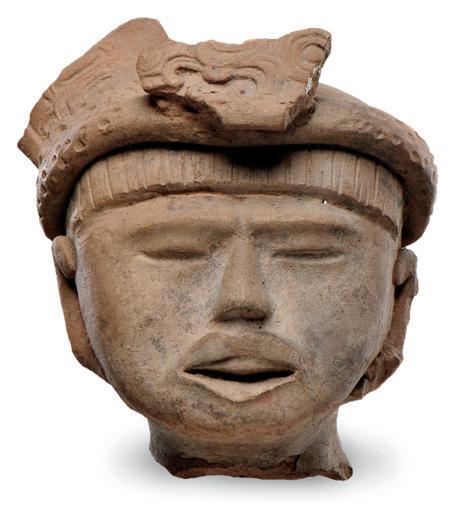
Central Veracruz
Early Classic. 400-600 A.D.
Mixtequilla, Southern Veracruz
Molded and modeled clay, with chapopote
94
Gallery 7 / Death
BURIALS AND COMPANIONS
The dead were normally mourned by their relatives in funeral ceremonies. Their remains were either wrapped in blankets and mats and then buried, or cremated so the ashes could be buried. There were other fairly widespread practices, such as placing a stone in the deceased person’s mouth or a mask over his face.
Some of the most common funerary offerings were vessels containing food or drink, as well as ceramic or stone figures that may have alluded to the person’s identity and function.
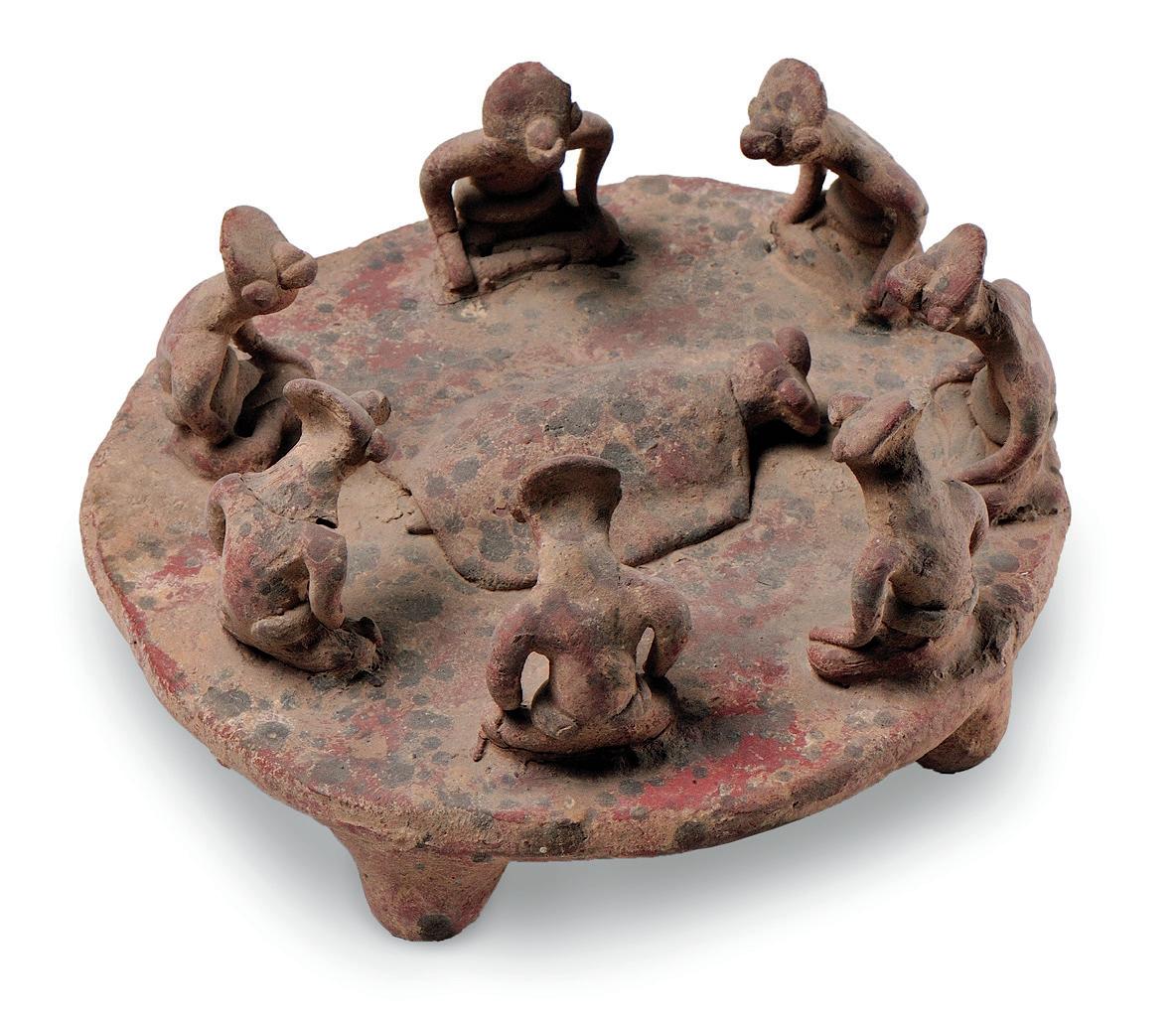
Depiction of a funeral
Shaft tomb tradition. Ixtlán del Río style
Late Preclassic-Early Classic. 300 B.C.-600 A.D.
Nayarit
Modeled clay, with pastillage and polychromy
95
Museo Amparo / The Pre-Columbian Collection
GALLERY 7
2. Resting dog shaped vessel

Dogs were much more important to the inhabitants of ancient Mexico than they are among present-day residents of Mexican cities, making it difficult for us to comprehend their past significance. There were at least three distinct dog breeds in Pre-Columbian times. Dogs accompanied humans throughout their lives, and were domesticated animals in the fullest sense of the word, even sleeping at night with people. Sometimes a dog would be sacrificed following a person’s death, so the animal’s soul could accompany that of its master, although a clay dog would sometimes be placed in the grave instead. Western shaft tombs were characterized by the use of large groups of burial companions, including ceramic dogs, which recreated the deceased person’s environment, as if part of his community accompanied him in death.
Resting dog shaped vessel
Shaft tomb tradition. Comala style
Late Preclassic-Early Classic. 300 B.C.-600 A.D.
Colima
Modeled, incised and burnished clay
96
Gallery 7 / Death
Figure of a robust dog in attentive attitude
Shaft tomb tradition. Comala style
Late Preclassic-Early Classic. 300 B.C.-600 A.D.

Colima
Modeled, incised and burnished clay
97
Museo Amparo / The Pre-Columbian Collection
GALLERY 7
OFFERINGS IN THE MEZCALA TRADITION
All pieces exhibited in museums once pertained to specific contexts that lent them meaning. But over time, for reasons of study and cataloguing, or given the manner in which they were sorted and stored in warehouses and showcases, individual pieces would be separated from the groups that originally accompanied them: vessels would be placed with vessels, masks with masks, stone sculptures with other similar ones. In many cases, it is impossible to reconstruct the original contexts, but archaeological investigation and studies of the styles and functions of different objects may give us an approximation.
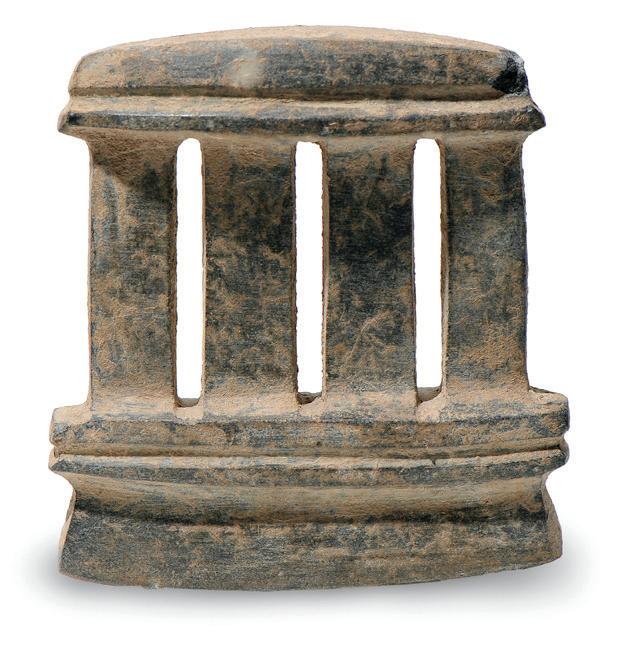
Most stone objects grouped under the label “Mezcala” were used in funerary offerings. We call them offerings because the objects were dedicated to the deceased and were buried with their remains. Many of these objects seem to have been intended to recreate a space or context, and to provide companionship for the dead. Burials included representations of temples, and figures of people and animals that seemed to reflect the individual’s social surroundings, while the masks that have been uncovered seem to have been attached to funeral bundles. Individuals of high status were probably buried along with their scepter or staff of office. The original groupings likely resembled the ones seen here.
Model of a building
Mezcala tradition
Late Preclassic-Late Classic.
500 B.C.-900 A.D.
Middle Balsas River basin
Scabbled, carved and polished stone
98
Gallery 7 / Death
Mask of a human face with wide open mouth and eyes

Mezcala tradition
Late Preclassic-Late Classic. 500 B.C.-900 A.D.
Middle Balsas River basin
Carved and polished stone
99
Museo Amparo / The Pre-Columbian Collection
GALLERY 7
Tripod container with zoomorphic lid
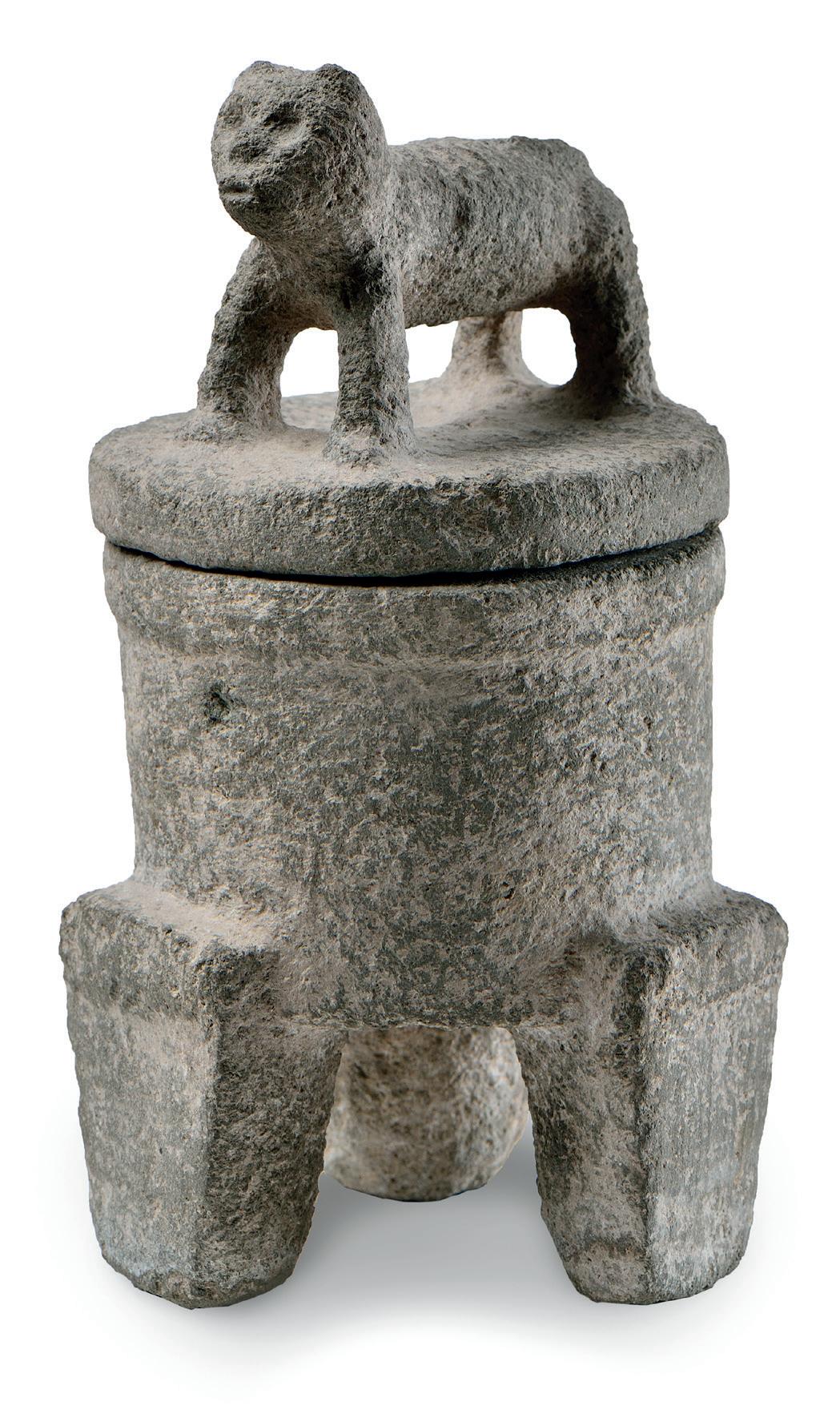
Mezcala tradition
Late Preclassic-Early Classic.
Ca. 300 B.C.-600 A.D.
Middle Balsas River basin
Carved and polished stone
100
Gallery 7 / Death
Monkey
Mezcala tradition
Late Preclassic-Late Classic. 500 B.C.-900 A.D.
Middle Balsas River basin
Stone cut out by abrading, carved and polished
Mesoamerican cultures believed in the existence of an underworld where the souls of the dead would arrive after traveling from their gravesites for four years. At the end of this voyage, they would present themselves upon the lord and lady of death, and their souls would be fragmented and scattered around the world.
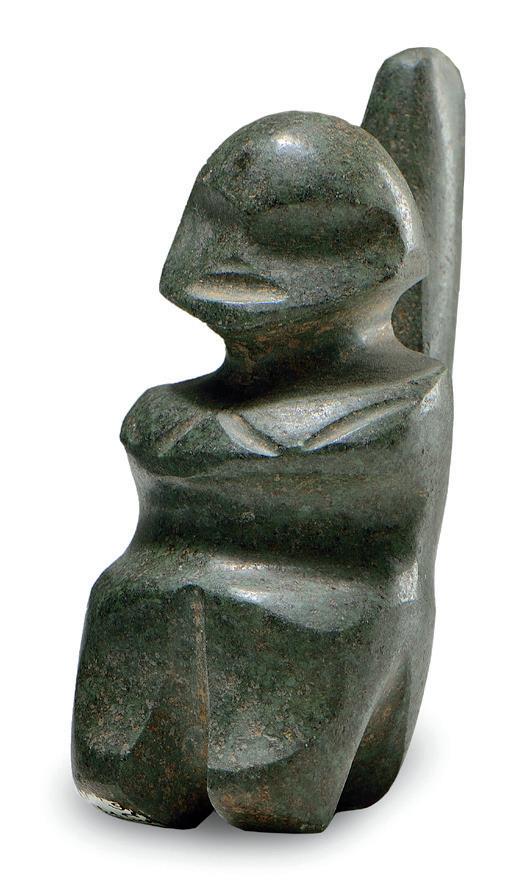
This painting likely represents this place of death. A dancing man has a completely fleshless head. Two skulls are seen lying on the ground, one of them apparently in flames. A priest with a sacrificial dagger tied to his waist carries out the ritual sacrifice of a quail.
The painting’s iconography and style are unsettling. The color and format are not distant from the Teotihuacan tradition, but it also depicts elements characteristic of the Gulf Coast.
(Following pages)
Mural painting fragment with a scene alluding to death and sacrifice
Classic. 200-900 A.D.
Gulf Coast or Central Mexico
Plateau
Mural painting on stucco
101 Museo Amparo /
The Pre-Columbian Collection
3. Mural painting fragment
GALLERY 7

102 Gallery 7 / Death
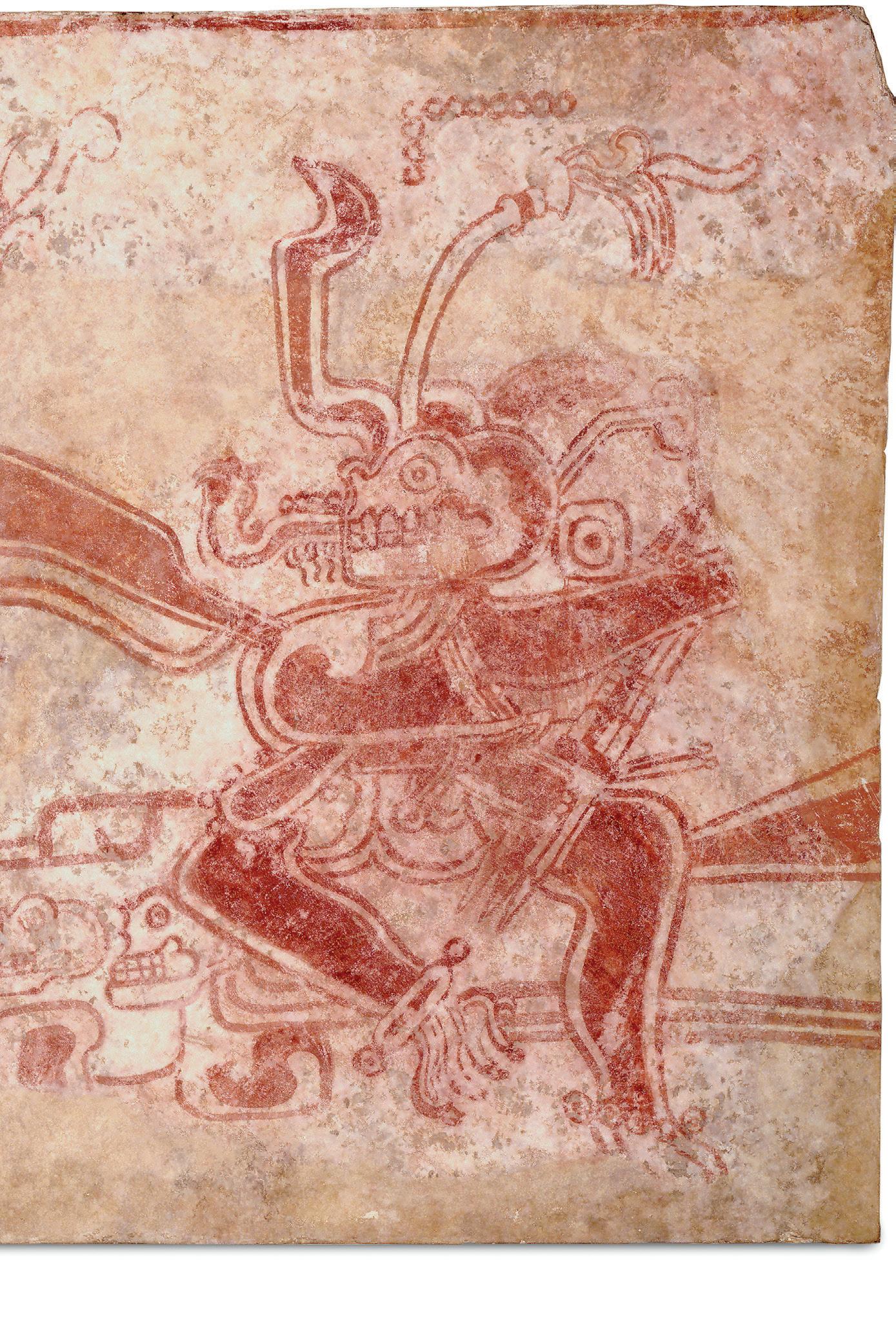
103 Museo Amparo / The Pre-Columbian Collection GALLERY 7
SHAFT TOMB
The cultures of Western Mesoamerica placed their dead in underground cavities that could be up to twenty meters deep. Vertical shafts similar to wells were dug, and a mortuary chamber would be excavated at the bottom.
Most of these were collective tombs, where several members of a single family would be buried. The dead were surrounded by numerous vessels, resembling a sumptuous banquet. In fact, a real banquet was likely held on the surface, leaving the deceased in the funerary chamber with enough food and drink for the voyage to be taken by his or her soul.
These deep chambers contained numerous anthropomorphic and animal figures that recreated an atmosphere of life that would accompany and encourage the deceased on their final voyage.
Eating coati
Shaft tomb tradition. Comala style
Late Preclassic-Early Classic.
300 B.C.-600 A.D.

Colima
Modeled clay
104
Gallery 7 / Death

105
Museo Amparo / The Pre-Columbian Collection
GALLERY 7
Shaft tomb
Cultural changes: the 16th century
The 16th century in New Spain was a period of profound changes, always marked by the oscillation between the indigenous cultural components and those of European origin. During the conquest there were violent battles, such as the one held at Tenochtitlan, but also alliances and negotiations, such as those that took place in Tlaxcala.
The Spaniards removed or destroyed the sculptures of indigenous deities, persecuted the ancient priests, and forbade ritual sacrifices. The friars began baptizing indigenous people and instructing them in the Catholic religion.
The sound of the drums in the temples was replaced by the church bells in order to announce the Liturgy of the Hours, although some PreColumbian dances continued being practiced, accompanied by the rhythm of smaller drums. The artisans adapted the Mesoamerican techniques to craft objects for the Catholic worship, such as baptismal fonts, sculptures of Christ and the saints, ceramic objects, feather banners, and gold ornaments.
In the field of the government and civil life, some members of the indigenous nobility preserved their identity, customs, and traditional authorities. They
106
GALLERY 8
became “pueblos de indios”, and each of them had its own town hall or government. Despite losing their lands and the burdens of the tax laws, several populations managed to maintain a way of life based on their former economic activities, incorporating some technological innovations, such as the use of iron, the pulley, and the waterwheel. Over time, indigenous nobility assimilated European customs. The leaders adopted the use of the cape, the sword, and the hat, and many of them learned how to ride horses.

107 Museo Amparo / The Pre-Columbian Collection
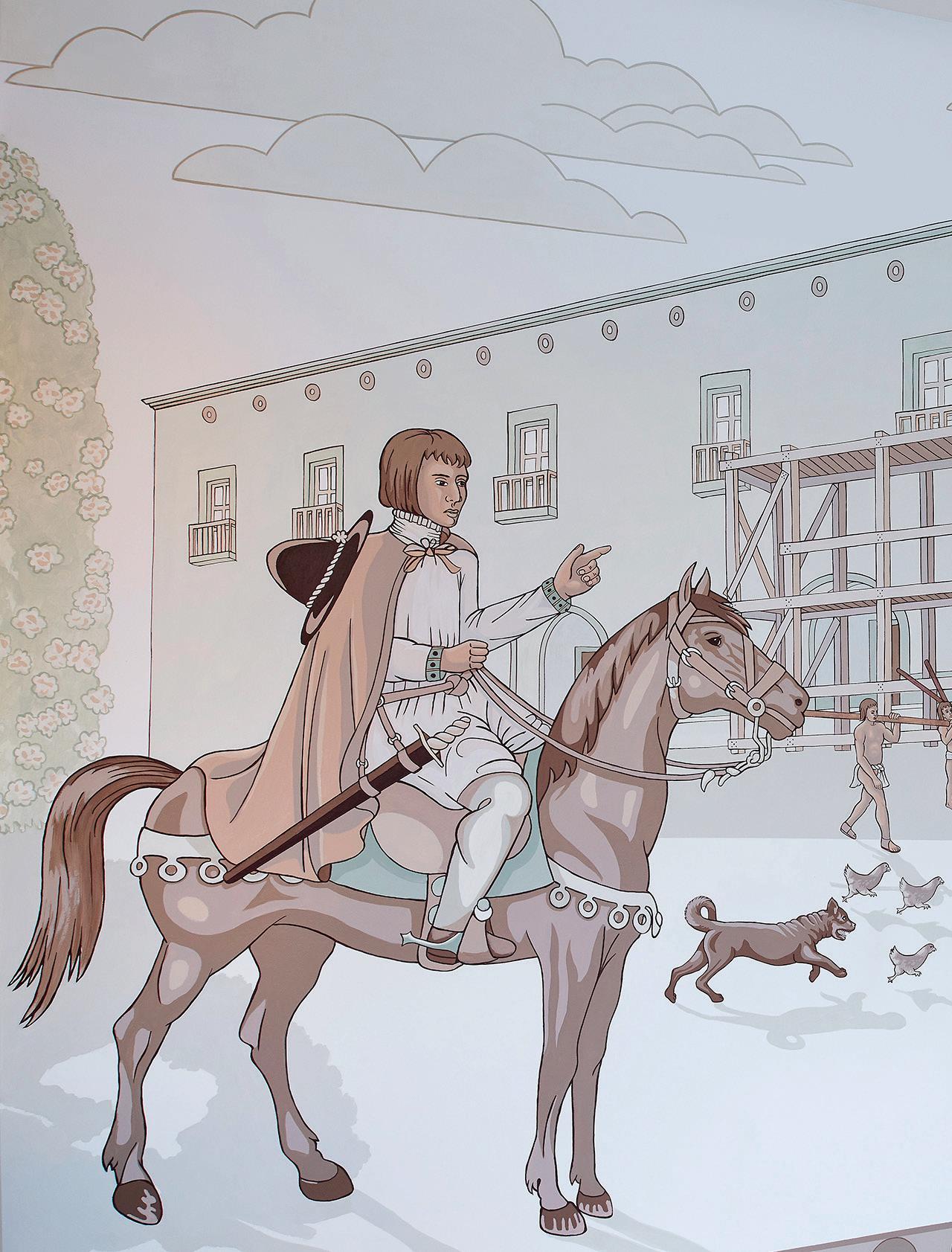
108 Gallery 8 / Cultural changes: the 16th century
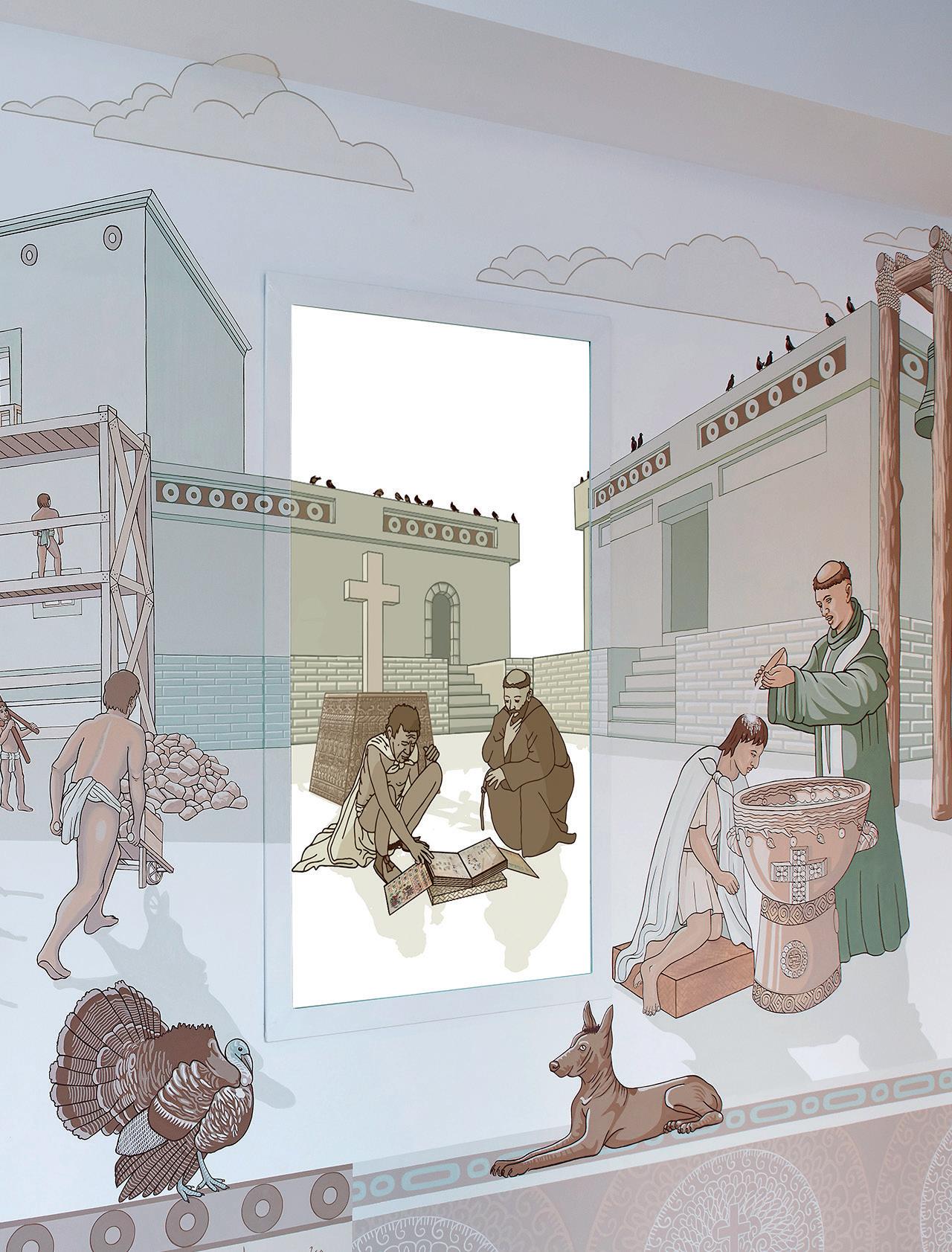
109 Museo Amparo / The Pre-Columbian Collection GALLERY 8

110 Gallery 8 / Cultural changes: the 16th century

111 Museo Amparo / The Pre-Columbian Collection GALLERY 8

112 Gallery 8 / Cultural changes: the 16th century

113 Museo Amparo / The Pre-Columbian Collection GALLERY 8
MUSEO AMPARO
Museo Amparo is a private institution committed to preserve, research, display, and disclose Pre-Columbian, viceregal, modern, and contemporary Mexican art.
Founded by Manuel Espinosa Yglesias and his daughter, Ángeles Espinosa Yglesias Rugarcía, the Museum opened its doors on February 28, 1991 with the goal of providing an overview of Mexican art from the Pre-Columbian period to the present day.
Based in the historical downtown area of Puebla, the Museum is housed in a magnificent viceregal building, built in 1538 for the San Juan de Letrán Hospital, which was the city’s first health institution. The first architectural renewal project for the exhibition rooms and galleries, as well as the initial museographic display was led by renowned architect Pedro Ramírez Vázquez.
On its 20th anniversary, Fundación Amparo undertook a renovation project in collaboration with architect Enrique Norten, with the goal of enhancing the experience of visitors and upgrading the spaces in harmonic coexistence with the architectural heritage, providing a better conservation of the building and the collections.
The Permanent Collection holds more than 1700 pieces of Pre-Columbian art, which reflect the artistic and cultural diversity of the inhabitants of ancient Mexico; as well as over 1300 pieces from the viceregal period and the 19th and 20th centuries. Besides, it gathers over 400 contemporary artworks.
The Museum also has an ongoing program of national and international temporary exhibitions as well as an intensive program of academic, artistic, educational, and ludic activities for all age groups.
Museo Amparo... un encuentro con nuestras raíces



www.museoamparo.com






















 Geometric Patio
Mayan throne backrest
The Religious World
Bodies, Faces, People
Entrance to the Pre-Columbian Collection Lobby
Geometric Patio
Mayan throne backrest
The Religious World
Bodies, Faces, People
Entrance to the Pre-Columbian Collection Lobby















































































































